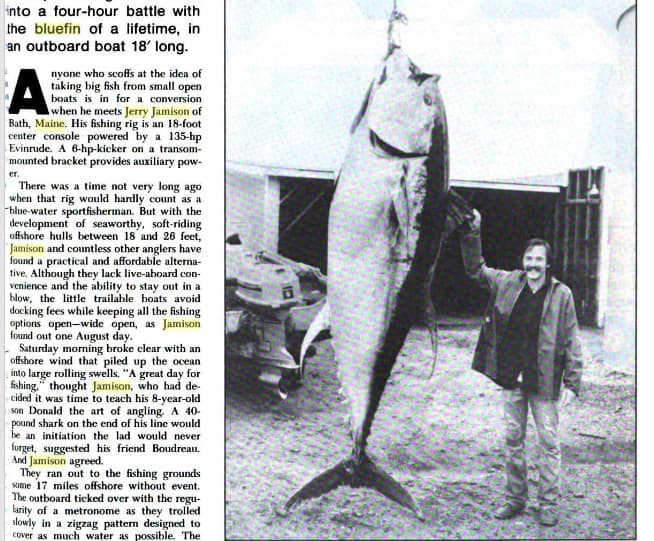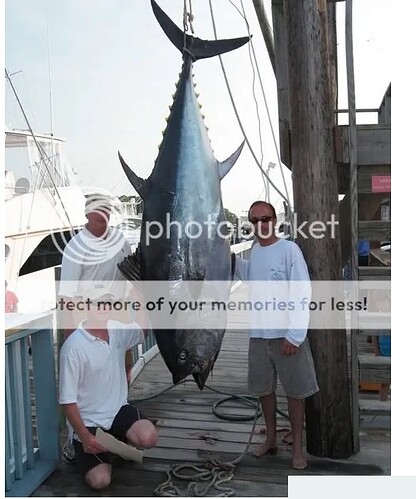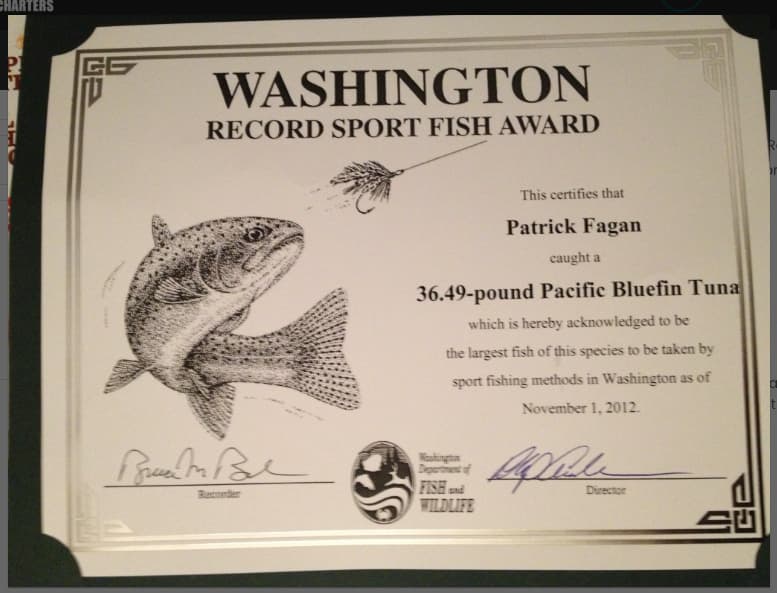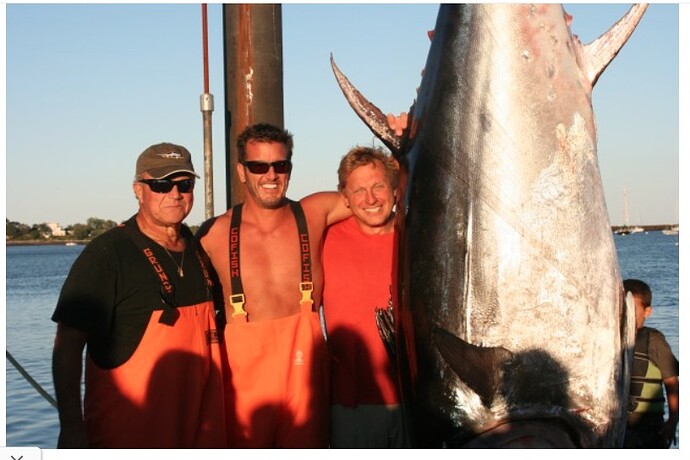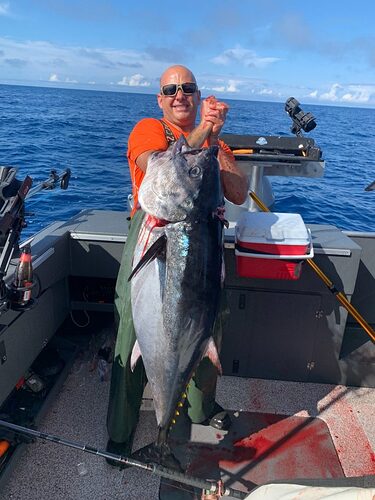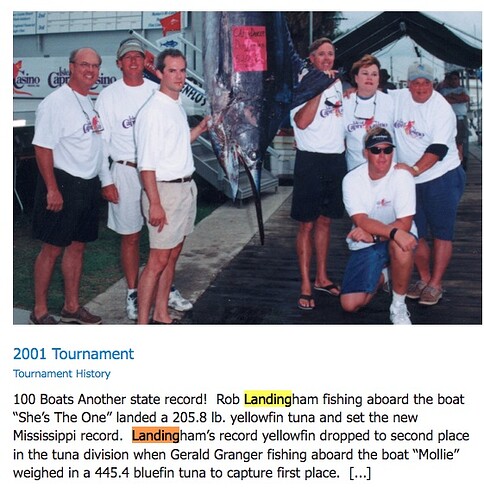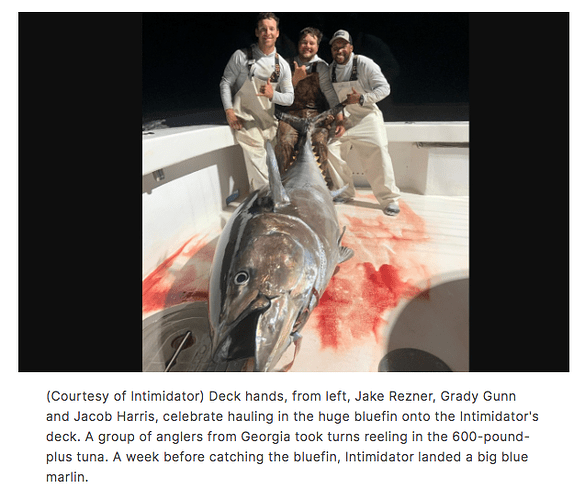Le Boeuf: One time, in New Mexico, we was being pursued by seven men. I turned Bo around and, taking them reins in my teeth, rode right at them boys, firing them two Navy Sixes I carry in my saddle. Well…I guess they was all married men who loved their families, as they scattered and run for home.
Mattie Ross: Well that is hard to believe.
Rooster Cogburn: What is?
Mattie Ross: One man riding at seven.
Rooster Cogburn: Well, it’s true. You go for a man hard enough and fast enough, he don’t have time to think about how many is with him. He thinks about himself. And how he might get clear of that wrath that’s about to set down on him.”
From the movie “True Grit”, written by Joel Cohen and Ethan Cohen, 2010, based on the novel by Charles Portis, 1968

(Jeff Bridges as Rooster Cogburn in “True Grit”, 2010)
BLUEFIN TUNA STATE RECORDS
1971 - Rhode Island - fabricated
1975 - Maryland - fabricated
1977 - New York - fabricated
1977 - Maine - verified - 819 pounds
1981 - Maine harpoon - fabricated
1981 - New Jersey - verified - 1,030 pounds
1984 - Massachusetts - verified - 1,228 pounds
2000 - Connecticut - verified - 1,012 pounds
2001 - New Hampshire - fabricated
June 6, 2003 - Virginia - fabricated
November 5, 2003 - Virginia - fabricated
2005 - Delaware - verified - 873 pounds
2006 - South Carolina - verified - 396 pounds, 14 ounces
2007 - Virginia - verified - 573 pounds
2011 - North Carolina - verified - 805 pounds
2013 - New Hampshire - verified - 962 pounds
2014 - Washington - verified - 39.2 pounds
2015 - Virginia - verified - 606 pounds
2017 - Florida - verified - 826 pounds, 8 ounces
2024 - Alabama - verified - 831 pounds, 6 ounces
From 1971 to 2024, there are twenty bluefin tuna state records.
From 1971 to 2024, seven of the twenty, or 35% of the bluefin tuna state records are fabricated.
There is no Georgia state record bluefin tuna, nor is there a Rhode Island state record bluefin tuna. Why?
There is no Maryland state record bluefin tuna; the 1975 Maryland state record bluefin tuna is fabricated.
There is no New York state record bluefin tuna; the 1977 New York state record bluefin tuna is fabricated.
There is no New Hampshire state record bluefin tuna; the 2001 New Hampshire state record bluefin tuna is fabricated.
There was no Maine state record bluefin tuna until 1977; the 1981 Maine harpoon state record bluefin tuna is fabricated.
In August 1977, the bluefin tuna winked into existence in the Atlantic Ocean off Maine. It weighed 819 pounds.
In 1979, sc.gov states that T.C. Lewis caught the South Carolina state record yellowfin tuna, and that it weighed 241 pounds, 12 ounces.
However, there are no independent news accounts documenting the catch, and there are no photographs of this fish.
The 1979 South Carolina state record bluefin tuna is fabricated; there was no South Carolina state record bluefin tuna until 2006.
There was no New Jersey state record bluefin tuna until 1981.
In 1981, the bluefin tuna winked into existence in the Atlantic Ocean off New Jersey. It weighed 1,030 pounds.
There was no Massachusetts state record bluefin tuna until 1984.
In 1984, the bluefin tuna winked into existence in Cape Cod Bay off Massachusetts, where it had never been documented previously. It weighed 1,228 pounds.
There was no Connecticut state record bluefin tuna until 2000.
In 2000, the bluefin tuna winked into existence in Block Island Sound off Connecticut. It weighed 1,012 pounds.
In 2005, the bluefin tuna winked into existence in the Atlantic Ocean off Delaware, where it had never been documented previously. It weighed 873 pounds.
In January 2006, the bluefin tuna winked into existence in the Atlantic Ocean off South Carolina, where it had never been documented previously, at a weight of 396 pounds, 14 ounces.
There was no Virginia state record bluefin tuna until 2007; the June 6, 2003 Virginia state record bluefin tuna is fabricated, and the November 5, 2003 Virginia state record bluefin tuna is fabricated.
In June 2007, the bluefin tuna winked into existence in the Atlantic Ocean off Virginia, where it had never been documented previously. It weighed 573 pounds.
There was no North Carolina state record bluefin tuna until 2011; the 1979 North Carolina state record bluefin tuna is fabricated.
In March 2011, the bluefin tuna winked into existence in the Atlantic Ocean off North Carolina, where it had never been documented previously. It weighed 805 pounds.
There was no Louisiana state record yellowfin tuna until 2012; the 2005 Louisiana state record bluefin tuna is fabricated.
There was no New Hampshire state record bluefin tuna until 2013.
In August 2013, the bluefin tuna winked into existence in the Atlantic Ocean off New Hampshire, where it had never been documented previously. It weighed 962 pounds.
There was no Washington state record bluefin tuna until 2014; the 2012 Washington state record bluefin tuna is fabricated.
In November 2014, the bluefin tuna winked into existence in the Pacific Ocean off Washington, where it had never been documented previously, at a weight of 39.2 pounds.
In 2017, the bluefin tuna winked into existence simultaneously in the Atlantic Ocean off Florida and England, and winked back into existence in Maine for the first time since 1998, and winked back into existence in North Carolina for the first time since its initial manifestation there in 2011.
In 2017, after an absence of almost twenty years, the bluefin tuna winked back into existence in Maine, for the first time since 1998.
There was no Florida state record bluefin tuna until 2017.
In May 2017, the bluefin tuna winked into existence in the Atlantic Ocean off Florida, where it had never been documented previously, at a weight of 826 pounds, 8 ounces.
In December 2017, the bluefin tuna winked into existence off the southern coast of England, where it had never been documented previously, at a weight of 350 pounds.
There were no bluefin tuna in the Salish Sea until 2023.
The bluefin tuna did not appear in the Gulf of Mexico until May 2023; the 2006 Alabama state record bluefin tuna is fabricated.
In 2023, the bluefin tuna winked into existence simultaneously in the Gulf of Mexico off Alabama and in the Salish Sea.
In May 2023, the bluefin tuna winked into existence in the Gulf of Mexico off Alabama, where it had never been documented previously, at a weight of 600 pounds.
It was not awarded the Louisiana state record thanks to the fraudulent 829-pound 2006 Louisiana state record purported by some to have been caught by some serially-unidentified person at some serially-unidentified location.
In July 2023, the bluefin tuna winked into existence in the Salish Sea, where it had never been documented previously, at a weight of 250 pounds.
From May 2023 to May 2024, the bluefin tuna in Alabama increased in size by 38.6%, from 600 pounds to 831 pounds, 6 ounces.
On May 29, 2024, David Gaston caught the first-ever Alabama state record bluefin tuna. It weighed 831 pounds, 6 ounces.
YELLOWFIN TUNA STATE RECORDS
1973 - Georgia women’s - fabricated
1979 - North Carolina - fabricated
1979 - South Carolina - fabricated
1980 - Georgia men’s - fabricated
1980 - New Jersey - fabricated
1981 - Virginia - fabricated
1990 - Massachusetts - fabricated
1991 - Connecticut - fabricated
1997 - Rhode Island - fabricated
2002 - New York - fabricated
2002 - Florida - fabricated
2005 - Louisiana - fabricated
2012 - Louisiana - verified - 251 pounds
2020 - Alabama - verified - 230 pounds
2020 - Mississippi - verified - 236 pounds, 9.6 ounces
2022 - New Jersey - verified - 236.5 pounds.
A current fisheries.noaa.gov article says of the Atlantic yellowfin tuna “the stock is not overfished”, and that “U.S. wild-caught Atlantic yellowfin tuna is a smart seafood choice because it is sustainably managed and responsibly harvested under U.S. regulations”.
Further, a July 2024 article on onthewater.com says “Atlantic yellowfin tuna have four major spawning areas, including the Caribbean, the Gulf of Mexico, and off the coast of Africa.”
From 1973 to 2024, there are fifteen yellowfin tuna state records.
From 1973 to 2024, twelve of the fifteen, or 80% of the yellowfin tuna state records are fabricated.
From 1973 to 2005, twelve of twelve , or 100% of the yellowfin tuna state records are fabricated.
There are just four verfiable yellowfin tuna state records (Louisiana, 2012; Alabama, 2020; Mississippi, 2020; and New Jersey, 2022).
Why are there no verifiable yellowfin tuna state records prior to 2012?
The fact of the matter is that, while yellowfin tuna are plentiful in many places, prior to 2012 the degradation of the etheric environment in the waters off the coast of the United States was such that the yellowfin tuna simply could not manifest there.
There is no state record yellowfin tuna in Delaware, Maine, or New Hampshire.
If the Atlantic yellowfin tuna is not overfished, and U.S. wild-caught Atlantic yellowfin tuna is a smart seafood choice, and one of the four major spawning areas of the yellowfin tuna is the Caribbean, then why is there no state record tuna in Delaware, Maine or New Hampshire?
There is no verifiable state record yellowfin tuna in Delaware, Florida, Georgia, Maine, New Hampshire, New York, North Carolina, Rhode Island, South Carolina or Virginia.
If the U.S. yellowfin tuna stock is not overfished, and U.S. wild-caught Atlantic yellowfin tuna is a smart seafood choice, and one of the four major spawning areas of the yellowfin tuna is the Caribbean, then why is there no verifiable state record yellowfin tuna in Delaware, Florida, Georgia, Maine, New Hampshire, New Jersey, New York, North Carolina, Rhode Island, South Carolina or Virginia?
There is no Rhode Island state record yellowfin tuna; the 1971 Rhode Island state record bluefin tuna is fabricated.
There is no Georgia state record yellowfin tuna; the 1973 women’s Georgia state record yellowfin tuna is fabricated, and the 1980 men’s Georgia state record yellowfin tuna is also fabricated. .
There is no North Carolina state record yellowfin tuna; the 1979 North Carolina state record yellowfin tuna is fabricated.
There is no South Carolina state record yellowfin tuna; the 1979 South Carolina state record yellowfin tuna is fabricated.
There is no New Jersey yellowfin tuna state record; the 1980 New Jersey yellowfin tuna record is fabricated.
There is no Virginia state record yellowfin tuna; the 1981 Virginia state record yellowfin tuna is fabricated.
There is no Massachusetts state record yellowfin tuna; the 1990 Massachusetts state record yellowfin tuna is fabricated.
There is no Connecticut state record yellowfin tuna; the 1991 Connecticut state record yellowfin tuna is fabricated.
There is no Rhode Island state record yellowfin tuna; the October 1997 Rhode Island state record yellowfin tuna is fabricated.
There is no New York state record yellowfin tuna; the 2002 New York state record yellowfin tuna is fabricated.
There is no Florida state record yellowfin tuna; the 2002 Florida state record yellowfin tuna is fabricated.
In October 2012, the yellowfin tuna winked into existence in the Gulf of Mexico off Louisiana, where it had never been documented previously. It weighed 251 pounds.
In June 2018, the yellowfin tuna winked into existence in the Atlantic Ocean off South Carolina, where it had never been documented previously. It weighed approximately 150 pounds.
There was no Alabama state record yellowfin tuna until March 2020.
There was no Mississippi state record yellowfin tuna until March 2020.
In March 2020, the yellowfin tuna winked into existence simultaneously in the Gulf of Mexico off of Alabama and Mississippi.
In March 2020, the yellowfin tuna winked into existence in the Gulf of Mexico off Alabama, at a weight of 230 pounds.
In March 2020, the yellowfin tuna winked into existence in the Gulf of Mexico off Mississippi, where it had never been documented previously, at a weight of 236 pounds, 9.6 ounces.
There was no New Jersey state record yellowfin tuna until 2022.
In September 2022, the yellowfin tuna winked into existence in the Atlantic Ocean off New Jersey. It weighed 236.5 pounds.
TUNA - ALL THE DATA
From 1971 to 2024, there are nineteen state record bluefin tuna.
From 1971 to 2024, seven of the nineteen, or 37% of the state record bluefin are fabricated.
There is no Georgia state record bluefin tuna, nor is there a Rhode Island state record bluefin tuna. Why?
In September 1971, eregulations.com says that J. Dempsey caught the Rhode Island state record bluefin tuna off Block Island, and that it weighed 1,142 pounds, 12 ounces.
However, there are no independent news accounts of the catch, and there are no photographs of the fish.
The 1971 Rhode Island state record bluefin tuna is fabricated.
There is no Rhode Island state record bluefin tuna.
In 1973, per the Georgia DNR’s eregulations.com, Anne Smith caught the women’s Georgia state record yellowfin tuna, which weighed 165 pounds, 4 ounces.
However, there are no independent news articles documenting the catch, and there are no photographs of the fish.
There is no Georgia state record yellowfin tuna.
The 1973 women’s Georgia state record yellowfin tuna is fabricated, and the 1980 men’s Georgia state record yellowfin tuna is also fabricated.
The 1975 Maryland state record bluefin tuna is fabricated.
There is no Maryland state record bluefin tuna.
On August 3, 1975, maryland.gov claims that James Daniels IV caught the Maryland state record bluefin tuna 45 miles East of Ocean City, and that it weighed 625 pounds.
Whatsupmag.com, coastal-fisherman.com, stacker.com and countless others repeat the ruse, however there are no independent media accounts of the catch, and there are no photographs of the fish.
It is a fabricated record, put in place so that, when the bluefin tuna suddenly winks into existence in Maryland, everyone can say “well, they’ve been there all along! James Daniels caught a big one back in ’75!”
From 1977 to 1981, the verified state record Atlantic bluefin tuna increased in size by 25.8%, from 819 pounds (Maine) to 1,030 pounds (New Jersey).
From 1977 to 1981, the verified state record Atlantic bluefin tuna increased in size by an annual average of 6.5%.
In August 1977, the bluefin tuna winked into existence in the Atlantic Ocean off Maine. It weighed 819 pounds.
From August 10, 1977 to September 7, 1998, the bluefin tuna is absent from the record in Maine.
From August 10, 1977 to October 26, 1979, the bluefin tuna in this study increased in size by 82.7%, or nearly doubled in size, from 819 pounds to 1,496 pounds.
On August 10, 1977, Jerry Jamison caught the first-ever Maine rod and reel state record bluefin tuna, in Bath. It weighed 819 pounds.
(Jerry Jamison with the 819-pound Maine rod and reel state record bluefin tuna, August 10,1977)
On August 23, 1977, the New York Times published an article stating that Larry Thompson had caught the largest bluefin tuna ever caught in U.S. waters, off Block Island, and that it weighed 1,071 pounds. It is the current New York state record per ny.gov.
There is a single New York Times story documenting the catch.
However there are no photographs of this fish. Given the gigantic size of this fish, there would have been more than one news story, and there certainly would have been pictures of it.
Having the only story be in the Nation’s largest newspaper is a tell. Long Island newspapers would have picked up/written this story, prior to it getting to the New York Times.
The 1977 New York state record bluefin tuna is fabricated.
There is no New York state record bluefin tuna.
In 1979, nc.gov states that James Mixon, Jr. caught the North Carolina state record yellowfin tuna, off Cape Lookout, and that it weighed 237 pounds.
However, there are no independent news articles verifying this catch, and there are no photographs of this fish.
The 1979 North Carolina state record yellowfin tuna is fabricated.
There is no North Carolina state record yellowfin tuna.
On October 26, 1979, Ken Fraser caught the world all-tackle record bluefin tuna off Nova Scotia. It weighed 1,496 pounds.
(Ken Fraser with 1,496-pound all-tackle world record bluefin tuna, Nova Scotia, October 26, 1979)
In 1980, nj.gov says that Wayne Brinkerhoff caught the New Jersey state record yellowfin tuna, in Hudson Canyon, and that it weighed 290 pounds.
However, there are no independent news accounts documenting this catch, and there are no photographs of this fish.
In 1980, per the Georgia DNR’s eregulations.com, Ken Cooper caught the men’s Georgia state record yellowfin tuna, which weighed 249 pounds, 2 ounces.
However, there are no independent news articles documenting the catch, and there are no photographs of the fish.
The 1980 men’s Georgia state record yellowfin tuna is fabricated, and the 1973 women’s Georgia state record yellowfin tuna is also fabricated.
There is no Georgia state record yellowfin tuna.
The 1980 New Jersey yellowfin tuna record is fabricated.
There is no New Jersey yellowfin tuna state record.
There was no New Jersey state record bluefin tuna until 1981.
From 1981 to 1984, the verified state record Atlantic bluefin tuna increased by 19.2%, from 1,030 pounds (New Jersey) to 1,228 pounds (Massachusetts).
From 1981 to 1984, verified state record Atlantic bluefin tuna increased in size by an annual average of 6.4%.
From 1981 to 1984, the 6.4% average annual increase in size of the verified state record Atlantic bluefin tuna was 1.5% less than its 6.5% average annual increase from 1977 to 1981.
This supports the position of mean-spirited Western Materialism, which holds that organisms increase in ever-smaller increments to a genetically-programmed maximum size.
Having said that, I would question these 20%-esque increases in size of a species over just a few years. How is Darwin’s “survival of the fittest” and his “theory of Evolution” explaining these quantum increases in size?
It also far-more-readily supports my thesis that, from 1977 to 1984, the health of the ether was being degraded at an increasing rate by the ever-increasing production of low-wavelength microwave radiation. Which in turn degraded the growth rate of the bluefin tuna, given that the size, fertility, longevity, and very existence of any organism vary directly with the health of its etheric environment.
In 1981, Royal Parsons caught the first-ever New Jersey state record bluefin tuna off Point Pleasant. It weighed 1,030 pounds, 6 ounces.

(Royal Parsons with the 1,030-pound New Jersey state record bluefin tuna, 1981)
In 1981, the bluefin tuna winked into existence in the Atlantic Ocean off New Jersey. It weighed 1,030 pounds.
On August 20, 1981, maine.gov, untamedmainer.com and countless others claim that Tim Tower and Percy Stevens, Jr. caught the Maine harpoon record bluefin tuna in Perkins Cove, Ogunquit, and that it weighed 1,155 pounds.
However, there are no independent news accounts documenting the catch, and there are no photographs of the gigantic fish. It is yet another false record.
The August 1981 Maine harpoon state record bluefin tuna is fabricated.
In 1981, virginia.gov states that Bruce C. Gottwald, Jr. caught the Virginia state record yellowfin tuna, in Norfolk Canyon and that it weighed 203 pounds, 12 ounces.
However, there are no independent news articles documenting this catch, and there are no photographs of this fish.
The 1981 Virginia state record yellowfin tuna is fabricated.
There is no Virginia state record yellowfin tuna.
From 1982 to 1995, the 2.9% average annual increase in size of the California spearfishing state record tuna was 2,799% greater than the .1% average annual increase in size of the North Carolina state record bluefin tuna during the same time period.
I believe that this shows the fish winking into and out of existence in these locales, with widely-varying weights based upon differences in the etheric environment where they manifested.
From June 1, 1982 to June 22, 2016, the California spearfishing state record bluefin tuna increased in size by 175.2%, or close to tripled in size, from 98 pounds to 269 pounds, 11 ounces.
From June 1, 1982 to June 3, 2016, the California spearfishing state record bluefin tuna increased in size by 76.8%, or close to doubled in size, from 98 pounds to 173.3 pounds.
On June 1, 1982, Terry Maas caught the California spearfishing state record bluefin tuna, at Cortes Bank off Orange County. It weighed 98 pounds.
From 1984 to 2000, verified state record Atlantic bluefin tuna increased in size by 17.6%, from 1,228 pounds (Massachusetts) to 1,012 pounds (Connecticut).
Another near-20% increase, in just six years. This is not explainable by Darwinism, by “Evolution”.
From 1984 to 2000, the 2.9% average annual increase in size of verified state record Atlantic bluefin tuna was 54.7% less than their 6.4% average annual increase in size from 1981 to 1984.
This is the indelible signature of the low-wavelength microwave radiation from what we collectively refer to as “Technology” degrading the growth rate of the bluefin tuna at an ever-greater rate.
From 1984 to 2017, the yellowfin tuna is absent from the record in California for 33 years. Either it was there all along, albeit at a size smaller than 239 pounds, or it was absent entirely, wiped out of existence there by the decrease in health of the etheric environment in Southern California. That, or the 1984 record is fabricated.
From 1984 to 2017, the yellowfin tuna increased in size by 11%, from 239 pounds (Catalina Island, California) to 265 pounds (Catalina Island, California).
In 1984, the bluefin tuna winked into existence in Cape Cod Bay off Massachusetts, where it had never been documented previously. It weighed 1,228 pounds.
On September 23, 1984, Marlene Goldstein caught the first-ever Massachusetts state record Bluefin Tuna in Cape Cod Bay, and that it weighed 1,228 pounds.
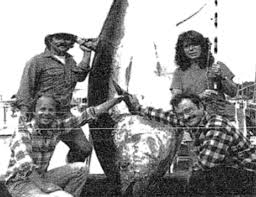
(Marlene Goldstein with the Massachusetts state record bluefin tuna, 1984)
In 1984, a yellowfin tuna was caught off Catalina Island in Southern California. It weighed 239 pounds.
In 1990, eregulations.com says that Lester Debetta caught the Connecticut state record bluefin tuna in Block Island Sound, and that it weighed 770 pounds.
However, there are no independent news stories documenting the catch, and there are no photographs of the fish.
The 1990 Connecticut state record bluefin tuna is fabricated.
On August 5, 1990, mass.gov says that the Mark Bojoukos caught the Massachusetts state record yellowfin tuna off Nantucket, and that it weighed 187 pounds.
However, there are no independent media account documenting this catch, and there are no photographs of this fish.
The August 1990 Massachusetts state record yellowfin tuna is fabricated.
In 1991, connecticut.gov says that “Cahrles” (we’ll presume that it is “Charles”) J. Lobacz caught the Connecticut state record yellowfin tuna in Block Island Sound’s Block Canyon, and that it weighed 210 pounds, 7 ounces.
However, there are no independent news stories documenting the catch, and there are no photographs of the fish.
The 1991 Connecticut state record yellowfin tuna is fabricated.
There is no Connecticut state record yellowfin tuna.
On July 10, 1995, Virginia Tech’s vt.edu stated “RECORD TUNA, 1ST SPADEFISH HIGHLIGHT AREA HAULS”.
Where Outdoor Editor Bob Hutchinson redacted the word “state” from “state record”, and omitted the name of the state under the false guise of familiarity.
Unfortunately for Bob, I fact-checked his claim, and there are no mentions of a 1995 North Carolina state record bluefin tuna in any independent media source, or are there any photographs of that 1995 record fish.
But, wait, it gets better. Bob goes on to say “The fish surpassed the previous record of 732 1/2 pounds held by Lyman Dickerson of Virginia Beach since 1979.”
It is the only mention of the 1979 North Carolina state record bluefin tuna in the historical record, and there are no photographs of the fish.
The July 1979 North Carolina state record bluefin tuna is fabricated.
In July 1995, Virginia Tech’s Outdoor Editor, Bob Hutchinson, fabricated a North Carolina bluefin tuna state record from 1979, and fabricated another North Carolina bluefin tuna from 1995, so that, later, when the bluefin tuna winked into existence in the Atlantic Ocean off North Carolina in 2011, there would be a “paper trail” in place to rebut it.
In October 1997, eregulation.com states that R. Hughes caught the Rhode Island state record yellowfin tuna at The Dip, and that it weighed 265 pounds.
However, there are no independent news accounts verifying the catch, and there are no photographs of this fish.
The October 1997 Rhode Island state record yellowfin tuna is fabricated.
There is no Rhode Island state record yellowfin tuna.
From September 7, 1998 to 2017, or for almost twenty years, the bluefin tuna is absent from the record in Maine.
On September 7, 1998, after an absence of over twenty years, the bluefin tuna winked back into existence in Maine at a weight of 810.0 pounds, which was 1% smaller than the 819 pounds at which it had last manifested there in August 1977.
On September 7, 1998, Ian Bexon caught the Maine handline record bluefin tuna. It weighed 810.0 pounds.
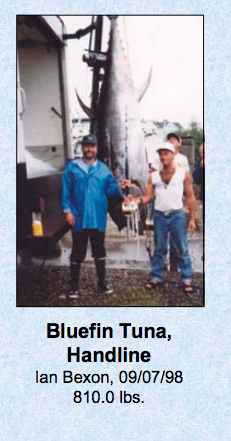
(Ian Bexon, Maine handline state record bluefin tuna, 1998)
From 2000 to 2005, verified state record Atlantic bluefin tuna decreased in size by 13.7%, from 1,012 pounds (Connecticut) to 873 pounds (Delaware).
We’ve now gone from three successive roughly-20% increases in size of the Atlantic bluefin tuna from 1977 to 2000, to a sudden 14% decrease in size from 2000 to 2005.
What is the variable from 2000 to 2005? The purportedly-harmless low-wavelength microwave radiation from what we collectively refer to as “Technology”.
In 2000, the bluefin tuna winked into existence in Block Island Sound off Connecticut. It weighed 1,012 pounds.
On October 19, 2000, the Hartford Courant said “Reelin’ In One For The Years”.
Where, spectacularly, the uncredited author omitted “Connecticut”, “state record”, and “bluefin tuna”.
The uncredited Intelligence operative from the State propaganda organ known as the Hartford Courant said “reelin’ in” to reinforce the false meme that far-larger bluefin tuna had been out there in Block Island Sound off Connecticut all along, only nobody pursued them with the proper skill or assiduousness, previously.
Given that the article is now behind a paywall, all I am able to divine is that Tom Hache caught a bluefin tuna in Block Island Sound off Connecticut, and that it weighed 1,012 pounds.
For some reason unknown to us, it was not awarded the Connecticut state record, and the fabricated 1990 record remained (and remains) in place.
On September 9, 2002, ny.gov says that Bruce Weisinger caught the New York state record yellowfin tuna, and that it weighed 248.5 pounds.
On September 9, 2002, on noreast.com, discussion starter Noreast said “We just got a call from Bruce Weisinger with the question “What’s the state record for a yellowfin tuna?” He has an approximate 275-pound yellow in the boat to go with 5 other yellows and 5-longfin. ’The big yellow took a bait right out of my hand and proceeded to make a few jumps as it tore line off of our Penn 80’, Bruce said.”
This is a fabricated forum entry, prepared by the Intelligence operative running under the avatar Noreast, in which purported state-champion angler rBruce Weisinger walked the first, only and biggest yellowfin tuna in the history of fishing in New York back to merely “big”, and said “took a bait right out of my hand” and “as it tore line off our Penn 80” to reinforce the false meme that yellowfin tuna had been out there in Block Island Sound all along, only nobody had pursued them with the proper skill or assiduousness, previously.
Both Bruce Weisinger and “Noreast” are fellow generational Satanist Freemasons, and their lurid claptrap is fabricated, given that there are no independent news accounts documenting this catch, and there are no photographs of this fish.
lurid - adjective - presented in vividly shocking or sensational terms, especially giving explicit details of crimes or sexual matters.
claptrap - noun - absurd or nonsensical talk or ideas.
The people who write this propaganda for a living proudly refer to it as “tradecraft”.
The 2002 New York state record yellowfin tuna is fabricated.
There is no New York state record yellowfin tuna.
On December 12, 2002, catchfloridamemory.com says that Michael Delph caught the Florida state record tuna out of Key West, and that it weighed 240 pounds.
However, there are no independent news accounts verifying the catch, and there are no photographs of the fish.
The 2002 Florida state record yellowfin tuna is fabricated.
There is no Florida state record yellowfin tuna.
A current article on fisheries.noaa.gov says of the Atlantic yellowfin tuna “The stock is not overfished”, and that “U.S. wild-caught Atlantic yellowfin tuna is a smart seafood choice because it is sustainably managed and responsibly harvested under U.S. regulations”.
Well, if all of that is true, then how can there not be a Florida state record yellowfin tuna? Or, if you are drinking the Kool-Aid, why is the only example of the yellowfin tuna in Florida in history from 2002?
What is being obscured here is the fact that, at this writing in August 2024, the etheric war has been successful to the point where, while there are scads of yellowfins other places, the yellowfin tuna cannot manifest within the Atlantic Ocean off Florida, and also off Georgia, directly to the North. There was no North Carolina state record yellowfin tuna until 2011. There was no South Carolina state record bluefin tuna until 2006.
On November 12, 2003, virginia.gov claimed “On November 5, 2003, Dr. James C. Wright of Virginia Beach boated a 393-pound fish that was certified as the new Virginia state record by the Virginia Saltwater Fishing Tournament. A scant 6 days later on November 11th, E.K. Morrison of Nags Head, NC landed a 398 lb., 8 oz. fish to set the latest record. Dr. Wright caught his fish at The Fingers off Virginia Beach while fishing with his son, Capt. David Wright, on the charterboat High Hopes. The bluefin, which measured 92 inches in length and had a girth of 62 inches, struck a ballyhoo trolled from an 80 pound class rod and reel spooled with 130 pound test line.
The prior state record of 357 pounds was caught southeast of the Cigar off Virginia Beach by Eddie Surratt, of Julian, NC on June 6, 2003.”
Here, Virginia Saltwater Fishing Tournament Director Claude Bain piles on with two false records, presented in rapid succession, because no one could imagine that someone could lie about two consecutive records in such a way.
Yet there are no media accounts of either of these catches, and there are no photographs of these purported largest-in-history fish.
They are fake records, put in place so that, when the bluefin tuna winked into existence in Virginia in 2007, there would be a paper trail in place to rebut it. “Oh, there were a couple of huge ones caught back in 2003, both state records.”
The June 6, 2003 Virginia state record bluefin tuna is fabricated.
The November 5, 2003 Virginia state record bluefin tuna is fabricated.
From 2005 to 2018, the volume of bigeye tuna production in the Philippines increased by 89%, or almost doubled.
From 2005 to 2006, the 54.5% decrease in size of verified state record Atlantic bluefin tuna was 1,846% greater than their 2.8% average annual decrease from 2000 to 2005.
2006 was the high-water mark of the Death energy-based technologies. That was the year that Hurricane Katrina was pumped up, driven around the Gulf of Mexico like a bumper car and driven straight into New Orleans.
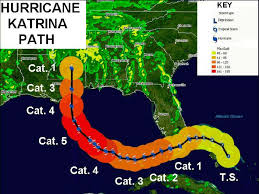
(Hurricane Katrina, 2006)
From 2005 to 2006, verified state record Atlantic bluefin tuna decreased in size by 54.5%, from 873 pounds (Delaware) to 396 pounds, 14 ounces (South Carolina).
In 2005, the bluefin tuna winked into existence in the Atlantic Ocean off Delaware, where it had never been documented previously. It weighed 873 pounds.
In March 2005, the Louisiana Sportsman’s M.A. Fisher states that Anthony Taormina caught the Louisiana state record yellowfin tuna at the Midnight Lump off the mouth of the Mississippi River, and that it weighed 240.19 pounds.
However, there are no independent news articles documenting this catch, and there are no photographs of this fish.
The March 2005 Louisiana state record yellowfin tuna is fabricated.
On July 2, 2005, Dan Dillon caught the first-ever Delaware state record bluefin tuna. It weighed 873 pounds.
Delware.gov said in comment “Atlantic Bluefin Tuna are eligible for the general “Tuna” record, which it holds”.
Here, despite numerous fabricated claims on sportsman websites and fishing forums to the contrary, the government of the state of Delaware does not mention a Delaware state record bluefin tuna prior to 2005.
In July 2005, the bluefin tuna winked into existence in the Atlantic Ocean off Delaware, at a weight of 873 pounds.
On July 3rd, 2005, Galilee Gale started a new thread on tidalfish.com, entitled “New State record Blue Fin Tuna caught yesterday”.
Gale’s statement “new state record” is brazenly false, given that there are no Delaware state record bluefin tuna prior to 2005.
The article goes on to say “The Capt. Ike brought in a new state record Bluefin Tuna yesterday to the DSSP North Shore Marina. It weighed 873# and was 115" long. The old DE recorw was 322#. The boat Capt. is Dave Collins and Mate is Mike Magee. The angler was Dan Dillon of Herndon VA. They caught on an overnight shark trip.”
Where Galilee Gale, whose fabricated name features a double Masonic G, doesn’t mention when the previous record was set, or who set it, or where it was set, or what the weight was.
That’s because “new state record” is a brazenly false claim, given that there are no Delaware state record bluefin tuna prior to 2005.
On July 3, 2005, on tidalfish.com, Galilee Gale said “The old DE record was 322#.”
Where “the old DE record” redacts “bluefin tuna”, under the false guise of familiarity.
Galilee Gale makes a grand, intellectual claim, about what the record number was, which amazes the rubes in the Punch and Judy tent, who don’t notice that the Operative, once again, not mentioned the name of the person who caught it, or the date, or its weight, or the location in which it was caught.
It’s a cloud of smoke which includes zero data…it is being used to create the false image that a Delaware state record for the bluefin tuna existed prior to 2005.
From 2006 to 2010, tuna in this study increased in size by 2.3%, from 396 pounds (Bluefin, South Carolina) to 405 pounds (yellowfin, Mexico).
From 2006 to 2010, tuna in this study increased in size by an annual average of .6%.
From 2006 to 2007, the 44.4% increase in size of the verified state record Atlantic bluefin tuna was 583% greater, or almost seven times greater than its 6.5% average annual increase from 1977 to 1981, which is the previous largest margin of increase in the data set.
Don Croft invented the simple, inexpensive Orgonite device in 2000. By 2007, many thousands of them had been distributed internationally. Here we are seeing their collective effect, along with the rising energy signature of the Earth heading toward the end of the Mayan Long Count in 2012.
From 2006 to 2007, verified state record Atlantic bluefin tuna increased in size by 44.4%, from 396 pounds, 14 ounces (South Carolina) to 573 pounds (Virginia).
On January 22, 2006, Jim Scott Middleton III caught the first-ever South Carolina state record bluefin tuna. It weighed 396 pounds, 14 ounces.
In February 2006, southeasternoutdoors.com said “Michael E. Stone, of Savannah, GA held the previous state record for Bluefin Tuna. Weighing in at 332-pounds, 6-ounces, he caught the former record fish in 1996 leaving out of Murrells Inlet and off the coast of North Carolina.”
Scducks.com, taxidermy.net, and others all faithfully repeat the ruse. However there are no independent news accounts of this 1996 South Carolina state record, nor are there any photographs of the fish.
It is a fabricated state record, claimed in 2006 only after the bluefin tuna had winked into existence in the Atlantic Ocean off South Carolina in January of that year.
In January 2006, the bluefin tuna winked into existence in the Atlantic Ocean off South Carolina, where it had never been documented previously, at a weight of 396 pounds, 14 ounces.
From June 2007 to April 2015, the Virginia state record bluefin tuna increased in size by 5.8%, from 573 pounds to 606 pounds.
From 2007 to 2015, the Virginia state record bluefin tuna increased in size by an annual average of .7%.
From 2007 to 2011, the 40.4% increase in size of the verified state record Atlantic bluefin tuna was 56.6% greater than its 25.8% increase from 1977 to 1981.
From 2007 to 2011, verified state record Atlantic bluefin tuna increased in size by 40.4%, from 573 pounds (Virginia) to 805 pounds (North Carolina).
From 2007 to 2011, verified state record Atlantic bluefin tuna increased in size by an annual average of 8%.
In June 2007, the bluefin tuna winked into existence in the Atlantic Ocean off Virginia, where it had never been documented previously. It weighed 573 pounds.
On June 24, 2007, tidalfish.com said “Pending State Record Bluefin Tuna weighed today”.
Where, under the false guise of familiarity, discussion-starter Dr. Julie Ball omitted “Virginia” from Virginia state record”, to make the subject less searchable.
That is an example of the propaganda technique known as “compartmentalization”.
The post goes on to say “I had the pleasure of witnessing the hoisting of a giant bluefin tuna at Fisherman’s Wharf Marina this evening. The fish tipped the scale at 573 pounds!”
Where Dr. Ball walked the first, only and largest bluefin tuna in the history back to merely “giant”.
The post goes on to say “The angler was Bo Haycox, fishing aboard the Episode Skippered by Johnny Savage. This giant fell to a pink Express rigged with a horse ballyhoo, on a bent butt 80. The angler faught the fish for 3 hours, 50 minutes.
Claude witnessed the weight, and measured the fish to complete the paper work as a submission for a new Virginia State Record.”
I highlighted a Medical Doctor spelling “fought” as “faught” for the record.
On June 24, 2007, Bo Haycox caught the first-ever Virginia state record bluefin tuna. It weighed 573 pounds.
(Bo Haycox with the first-ever Virginia state record bluefin tuna, 2007)
On August 6, 2007, at 11:03 p.m., on the fishing forum thehulltruth.com, thread starter Junior Member SEAYA12 said “Had a great trip Sunday out of Fouchon looking for Yellowfin and buy did we find them. Finished the day with 7 fish,2 in the 40 - 50# class, 3 in the 70-80# one that weighed 168# and the grand daddy that weighed in at 233 pounds. For those of you keeping score the is the third largest Yellowfin ever caught in the Gulf of Mexico.
Here is the rest of the story. The fish was landed at around 3:30 on Sunday but not weighed until 9:00 am on Monday beacuse there was no certified scale around by the time we got in. The fish was kept in an ice slurry overnight and weighed at Sanddollar Marine this morning.
My question is could this fish have lost 5 pounds overnight***?*** If so this fish would have broken the GOM record of 238 pounds.
I guess we will never know.
I will post pictures as soon as I can weed through the 200 shots we have”.
This is a pile of carefully crafted hearsay, put in place by the uncredited Intelligence operative known as SEAYA12 to give the false impression that there are yellowfin tuna in the Gulf of Mexico off Mississippi in August 2007.
Under the false guise of familiarity, they walked “yellowfin tuna” back to “yellowfin”, and then walked yellowfin back once again to “fish”. Then the 7 “fish” are walked back to “the fish”. And, golly, all the stumbling and bumbling just manage tokeep “the fish” off the books as the Gulf of Mexico record.
SEAYA12 avers that he will, indeed, post pictures, however he never does.
The fake record from 2005 and this fabricated “chatter on the ballfield” from 2007 are pieces in a paper trail created in preparation for the yellowfin tuna winking into existence in the Gulf of Mexico off Louisiana in 2012.
On August 6, 2007, at 11:21 p.m., Senior Member A Few Dollars replied “You only needed 2 lbs. 4 oz. to beat my buddy’s record fish…’Anthony Taormina IV, on the right shakes hands with Deckhand Hunter Caballero. Anthony Taormina fought this 240.3# Yellowfin Tuna while fishing with Strike Zone Charters. The catch is the largest Yellowfin Tuna ever caught in Louisiana and the Gulf of Mexico’.”
Where “Louisiana state record” and “Gulf of Mexico record” are inexplicably walked back to “the largest ever caught in Louisiana and the Gulf of Mexico”.
Spectacularly, there is no photograph. Senior forum member A Few Dollars simply posted what is purported to be the caption of a photograph.
The fake caption says “fought”, “fishing”, “catch” and “caught” to hammer the false meme that yellowfin tuna had been out there in the Gulf of Mexico off Louisiana all along, only nobody had pursued them with the proper skill or assiduousness, previously.
Senior Member “A Few Dollars” is an uncredited Intelligence operative, creating a piece of a false “paper trail” to establish “bona fides” for the false, fabricated Louisiana state record yellowfin tuna from 2005.
On August 7, 2007, at 8:01 a.m., Senior Member GotchaRB replied “I heard that… Sounds Like Fun!!”
Here, the ambiguous “I heard that” can be interpreted by the Coincidence theorist reader as a confirmation of the in-fact fabricated Louisiana state record yellowfin tuna from 2005. The propagandist uses “Sounds Like Fun!!”, where the capital letters and the double “bangs”, or exclamation points, distract from the sleight-of-hand.
The people who write this propaganda for a living proudly refer to it as “tradecraft”.
The uncredited Intelligence operative known as SEAYA12 didn’t post a photo of the (almost!) Gulf of Mexico yellowfin tuna because he had 200 pictures to “weed through”. Where he used “weed” to infer he was a lazy stoner, and never got to it (cough). While the uncredited Intelligence operative known as A Few Dollars didn’t post a photo of the 2005 Louisiana state record yellowfin tuna because he “forgot”, I guess.
I’ve got a lot of firsts to my credit, and identifying uncredited Intelligence operatives on Internet forums is certainly one of them.
Those operatives know that the key to any successful Confidence game is misdirection.
On September 21, 2007, an uncredited article on salwatersportsman.com widened its eyes to simulate honesty and said “Delaware’s New Giant of Giants”.
Where, under the false guise of familiarity, the uncredited author from Saltwater Sportsman redacted “bluefin tuna” and “state record”, and replaced it with the general “giant of giants”.
Where the word “new” and the plural “giants” falsely infer that a Delaware state record for the bluefin tuna existed prior to 2005.
For those unaware, anytime an author is uncredited, it is proof that said author is an Intelligence operative.
The uncredited Intelligence operative from the state propaganda organ known as saltwatersportsman.com goes on to say “Dan Dillon set a new Delaware state record for bluefin tuna with a 873-pound giant caught 45 miles southeast of the Indian River Inlet. Dillon’s bluefin crushed the previous state record of 322 pounds.”
Where “the previous state record” is general. It does not mention the name of the person who caught it, when it was caught, or where it was caught.
That’s because the article is making the brazenly false statement that a Delaware state record bluefin tuna existed prior to 2005.
To accept that falsehood you are going to need to affirm that, from some obfuscated date prior to 2005 to 2005, the Delaware state record bluefin tuna increased in size by 171%, or nearly tripled in size, from 322 pounds to 873 pounds.
Under the false guise of familiarity, the uncredited author redacted “tuna” from “bluefin tuna”, to make the subject less searchable
There are no independent media accounts or photographs documenting the Delaware state record bluefin tuna from prior to 2005.
I have exposed the duplicity of Saltwater Sportsman by using what was known in the old days as “fact checking”.
The truth is that, in July 2005, the bluefin tuna winked into existence in the Atlantic Ocean off Delaware, at a weight of 873 pounds.
From June 2007 to 2015, the Virginia state record bluefin tuna increased in size by 5.8%, from 573 pounds to 606 pounds.
From June 2007 to 2015, the Virginia state record bluefin tuna increased in size by an annual average of .7%.From 2010 to 2015, the .7% average annual increase in size of the Virginia state record bluefin tuna was 16.6% greater than than the .6% average annual increase in size of tuna in this study from 2006 to 2010.
The growth rate of tuna is increasing, going forward in time.
That’s not scientifically possible, at least not according to the rapidly-collapsing false Orthodoxy which holds that organisms increase in ever-smaller increments to a genetically-programmed maximum size, and that “there is no such thing as the ether.”
The truth is that the health of the ether is inexorably improving, and the size, fertility, longevity and very existence of any organism varies directly with the health of its etheric environment.
From 2010 to 2012, the 4.9% average annual increase in size of the yellowfin tuna in this study was 716.6% greater, or more than eight times greater than the .6% average annual increase in size of tuna in this study from 2006 to 2010.
From 2010 to 2012, the yellowfin tuna in this study increased in size by 9.8%, from 405 pounds (IGFA world record, Mexico) to 445 pounds (stripped IGFA world record, California).
Louisiana Sportsman’s Jerry Dilsaver omitted the percentage, and replaced it with “surpassed the existing world record by a full 40 pounds”.
From 2010 to 2012, the yellowfin tuna in this study increased in size by 9.8% and expanded its range from Mexico up to Southern California.
From 2010 to 2012, the size of the yellowfin tuna in this study increased by an annual average of 4.9%.
In 2010, the IGFA world record yellowfin tuna in Mexico weighed 445 pounds.
In 2010, the bluefin tuna winked into existence in Mexico at an IGFA world-record weight of 445 pounds.
Why is the 445-pound IGFA world record bluefin tuna from Mexico from 2010 22.3% smaller than the 573-pound Virginia state record bluefin tuna from June 2007?
From 2011 to 2018, the North Carolina state record bluefin tuna increased in size by 8.9%, from 805 pounds to 877 pounds.
From 2011 to 2017, the largest bluefin tuna ever caught off North Carolina increased in size by 29.8%, from 805 pounds (North Carolina state record) to 1,045 pounds (sold commercially).
From 2011 to 2017, the 5% average annual increase in size of the bluefin tuna in North Carolina was 2% greater than the 4.9% average annual increase in size of yellowfin tuna in this study from 2010 to 2011.
The growth rate of tuna is increasing exponentially, going forward in time.
That’s not scientifically possible, at least not according to the rapidly-collapsing false Orthodoxy which holds that organisms increase in ever-smaller increments to a genetically-programmed maximum size, and that “there is no such thing as the ether.”
The truth is that the health of the ether is inexorably improving, and the size, fertility, longevity and very existence of any organism varies directly with the health of its etheric environment.
From 2011 to 2017, the bluefin tuna is absent from the record.
From 2011 to 2013, verified state record Atlantic bluefin tuna increased in size by 19.5%, from 805 pounds (North Carolina) to 962 pounds (New Hampshire
From 2011 to 2013, the 9.8% average annual increase in size of the verified state record Atlantic bluefin tuna was 22.5% greater than its 8% average annual increase from 2007 to 2011.
In 2011, the bluefin tuna winked into existence in the Atlantic Ocean off North Carolina, at a weight of 805 pounds, after never being documented there previously.
In March 2011, Corey Schultz caught the first-ever North Carolina state record bluefin tuna. It weighed 805 pounds.
From 2012 to 2016, the 1.35% average annual increase in size of the world record yellowfin tuna was 1,250% greater than its .1% increase documented from 1977 to 2012.
From 2012 to 2016, the 1.35% and 1.5% average annual increases in size of the world record yellowfin tuna and the North Carolina state record bluefin tuna were statistically almost identical.
The growth rate of the yellowfin tuna is increasing at the same rate regardless of geography because the health of the ether is inexorably improving, and the size, fertility, longevity and very existence of any organism vary directly with the health of its etheric environment.
From 2012 to 2016, the average annual increase in size of the world record yellowfin tuna was 1.35%. (Figure this out)
In October 2012, the yellowfin tuna winked into existence in the Gulf of Mexico off Louisiana, where it had never been documented previously, as the health of the ether there improved to the point where the species could manifest within it. It weighed 251 pounds.
On October 1, 2012, washingtontunacharters.com said “October 1st, 2012, Patrick Fagan of Seattle, WA lands a State Record Bluefin tuna aboard “Reel Tight”. This 36.49lb BFT was hooked and landed during one of our Express Albacore tuna fishing trips out of Westport, WA. Congratulations Patrick!”
Where, under the false guise of familiarity, the uncredited author said “BFT” in place of “bluefin tuna”, to make the subject almost unsearchable.
That is an example of the propaganda technique known as “compartmentalization”.
For those unfamiliar, anytime an author is uncredited, it is proof that said author is an Intelligence operative.
The uncredited Intelligence operative from the State propaganda organ known as washingtontunacharters.com accompanied that statement with this image of a Washington Record Sport Fish Award from the Washington Department of Fish and Wildlife. The award states “this certifies that Patrick Fagan caught a 36.49-pound Pacific Bluefin Tuna which is hereby acknowledged to be the largest fish of this species to be taken by sport fishing methods in Washington as of November 1, 2012.”
(Washington Record Sport Fish Award falsified by the Washington Department of Fish and Wildlife, 2012)
Why doesn’t the washingtontunacharters.com article include a photo of first-ever Washington state record bluefin tuna angler Patrick Fagan, or of the Reel Tight, the boat he caught it on. Most crucially, why does the article from the tuna-enthusiast website not include a picture of the first-ever Washington state record bluefin tuna?
To preserve current programming levels, stop reading immediately, breathe through your mouth, glance sideways and affirm “but the Director signed it in blue ink, and it’s got gold leaf on it”.
Why does Patrick’s bluefin tuna weigh just 36.49 pounds, when, to name just one example out of many, the first-ever North Carolina bluefin tuna from March 2011 weighed 805 pounds?
Why doesn’t the article from the tuna-enthusiast website mention that Patrick’s catch is the first-ever Washington state record bluefin tuna?
The 2012 Washington state record bluefin tuna is fabricated, put in place to forestall the sudden appearance of the bluefin tuna in the Pacific Ocean off Washington state for the first time in history less than two years later, in 2014.
The folks at the Ministry of Truth quick created a website called “Washington Tuna Charters” to pretend that everyone in Washington was heading off on charter boats to catch tuna, you know, like, forever.
I have exposed the duplicity of Patrick Fagan (if he even exists), washingtontunacharters.com and the Washington Department of Fish and Wildlife by using what was known in the old days as “fact checking”.
October 13, 2012, Elliot Sale caught the first-ever Louisiana state record yellowfin tuna. It weighed 251 pounds.
Here’s a picture of it.
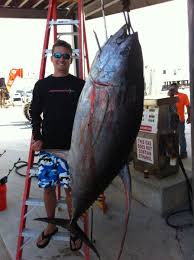
(Elliott Sale with the first-ever Louisiana state record yellowfin tuna, 251 pounds, October 13, 2012)
A current article on fisheries.noaa.gov says of the Atlantic yellowfin tuna “The stock is not overfished”, and that “U.S. wild-caught Atlantic yellowfin tuna is a smart seafood choice because it is sustainably managed and responsibly harvested under U.S. regulations”.
Further, a July 2024 article on onthewater.com says “Atlantic yellowfin tuna have four major spawning areas, including the Caribbean, the Gulf of Mexico, and off the coast of Africa.”
If one of the four main spawning areas of the yellowfin tuna is the Gulf of Mexico, and the yellowfin tuna is a smart seafood choice because it is sustainably managed, then why was there no Louisiana state record yellowfin tuna until 2012?
There are plenty of places where the yellowfin tuna is plentiful. What’s not being explained, here, is that the degradation of the health of the ether in the Gulf of Mexico off Louisiana was sufficient to keep the yellowfin tuna from manifesting there up until 2012.
2012 is the year that the great positive changes I’m documenting in these articles got underway in earnest. It’s the year that the Mayan “Long Count” ended. The beginning of a new “Golden Age”.
I began writing this series of article in July 2013.
On and on I bust through like teflon.
On October 16, 2012, louisianasportsman.com said “Pending state-record yellowfin caught out of Grand Isle”.
Where, under the false guise of familiarity, the humorously-named author M.A. Fisher omitted the name of the state, and omitted the word “tuna” from “yellowfin tuna” to make the subject almost unsearchable.
That is an example of the propaganda technique known as “compartmentalization.
For the record, it is the Louisiana state record yellowfin tuna.
The subhead reads ”West Delta gives up 251-pound tuna, crushes existing state record”.
Where, once again under the false guise of familiarity, author M.A. Fisher once again redacted the name of the state, and has now walked it back from “yellowfin tuna” to “yellowfin”, and then walked it back again to “tuna”.
They also obscured the date of the previous record, along with the specific margin between the old record and the new with the lurid-but-general “crushes existing state record”.
Those are examples of the propaganda technique known as “compartmentalization”.
Mr./Ms. Fisher said “West Delta gives up” to reinforce the false meme that far-larger yellowfin tuna had been out there in the West Delta, all along, only nobody had pursued them with the proper skill or assiduousness, previously.
The article goes on to say “A trip out of Grand Isle on Saturday (Oct. 13) ended with a pending new state-record yellowfin tuna hanging at the docks of Bridge Side Marina. The catch of the 251-pound yellowfin by New Iberia’s 22-year-old Elliot Sale will, if certified by the Louisiana Outdoor Writers Association, break an eight-year-old record.”
Here, Fisher once again obscured the date of the previous record, along with the specific margin between the old record and the new with the general “break and eight-year-old record”.
The propagandist used “catch” to reinforce the false meme that far larger yellowfin tuna had been out there in Louisiana all along, only nobody had pursued them with the proper skill or assiduousness previously.
The article goes on to say “The previous mark was held by Anthony Taormina, who landed a 240.19 pound yellowfin in March 2005 at the Midnight Lump off the mouth of the Mississippi River.
Where the propagandist walked the specific “Louisiana state record” back to the general “mark”, and used “landed” to reinforce the false meme that far larger yellowfin tuna had been out there off the mouth of the Mississippi River all along, only nobody had pursued them with the proper skill or assiduousness previously.
On October 16, 2012, the Louisiana Sportsman’s M.A. Fisher stated that, in March 2005, Anthony Taormina had caught the Louisiana state record yellowfin tuna at the Midnight Lump off the mouth of the Mississippi River, and that it weighed 240.19 pounds.
However, there are no independent news articles documenting this catch, and there are no photographs of this fish.
The 2005 Louisiana state record yellowfin tuna is fabricated.
Spectacularly, there are no photographs of the Louisiana Sportsman’s M.A. Fisher online. At the top of this article, I called bullshit as soon as I heard his name, “Fisher”.
“M.A. Fisher” is a pseudonym under which a variety of uncredited Intelligence operative published their propaganda.
I have exposed the duplicity of the Louisiana Sportsman by using what was known in the old days as “fact checking”.
From 2013 to 2019, Papua New Guinea’s tuna exports more than tripled.
From 2013 to 2015, the verified state record Atlantic bluefin tuna decreased in size by 37%, from 962 pounds (New Hampshire) to 606 pounds (Virginia).
In 2013, the 962-pound verified New Hampshire state record bluefin tuna was 17.4% larger than the 819-pound verified state record from neighboring Maine from 1977.
If my thesis that the size of any organism varies directly with the health of its etheric environment is correct, then here, in 2013, the ether is nearly 20% healthier than it has ever been in history, given that the first example of the Atlantic bluefin tuna on record is from 1977.In August 2013, the bluefin tuna winked into existence in New Hampshire, where it had never been documented previously. It weighed 962 pounds.
On August 13, 2013, Garth Morin, Bruce DelleChiaie and Rick Green caught the first-ever New Hampshire state record bluefin tuna. It weighed 962 pounds.
(Garth Morin, Bruce DelleChiaie and Rick Green with the New Hampshire state record bluefin tuna, August 13, 2013)
On August 22, 2013, in an onthewater.com article on the New Hampshire state record bluefin tuna, the uncredited author said “the previous record was set by Paul J. Wentworth, also of New Castle, in 2001 when he brought back an 865-pound bluefin. The documents for the new record were signed by witnesses but have yet to be officially verified by the NH Division of Fish and Game.”
However, there are no independent media accounts documenting the New Hampshire state record bluefin tuna from 2001, nor are there any photographs of the fish.
Coastal Angler magazine repeated the ruse on September 13, 2013, while seacoastonline.com did so on August 19, 2013.
The 2001 New Hampshire state record bluefin tuna is fabricated, put in place to forestall the bluefin tuna’s winking into existence in the Atlantic Ocean off New Hampshire for the first time in history in 2013.
I have exposed the duplicity of onthewater.com, Coastal Angler magazine, and seacoastonline.com by using what was known in the old days as “fact checking”.
From 2014 to 2019, the Washington state record bluefin tuna increased in size by an annual average of 27%.
From November 2014 to August 2019, the Washington state record bluefin tuna increased in size by 135%, or well more than doubled in size, from 39.2 pounds to 92.15 pounds.
From 2014 to 2015, the price of the first tuna sold at the Tsukiji fish auction in Japan decreased by 47%, from $70,000 to $37,000.
Prices decrease either when supply increases, demand decreases, or both.
In November 2014, Sam Ellinger caught the first-ever Washington state record bluefin tuna. It weighed 39.2 pounds.
In November 2014, the bluefin tuna winked into existence in the Pacific Ocean off Washington, where it had never been documented previously, at a weight of 39.2 pounds.
On November 25, 2014, wa.gov said “Ellensburg angler breaks Pacific bluefin tuna record”
Where, under the false guise of familiarity, the uncredited author omits the name of the state, and redacts the word “state” from “state record”, to avoid plainly stating “Washington state record bluefin tuna”.
Those are examples of the propaganda technique known as “compartmentalization”.
For those unaware, anytime an author is uncredited, it is proof that said author is an Intelligence operative.
Given that we’re in the midst of a scholarly article on the subject, we know that wa.gov’s statement “breaks Pacific bluefin tuna record” is false, given that there are no independent media accounts or photographs supporting the claimed Washington state record bluefin tuna from 2012.
The artilcle goes on to say “Sam Ellinger of Ellensburg has set a new state record for the largest Pacific bluefin tuna caught off the coast of Washington, the Washington Department of Fish and Wildlife (WDFW) confirmed today. The 39.20 pound fish measured 41 inches and was caught 28 miles offshore southwest of Grays Harbor, while bait fishing with anchovies.
Ellinger, a student at Central Washington University, said he began the day early and was fishing, “from the crack of dawn until it got dark.”
“Catching a fish this size was pretty exhausting,” added Ellinger. “We didn’t know what we hooked until we got it on the boat.”
The new record exceeded the previous record Pacific bluefin tuna weight by 2.71 pounds. That record was held by Patrick Fagan on a fish caught 35 miles offshore from Westport in 2012.”
Where wa.gov’s statement “new record” is false, given that there are no independent media accounts or photographs supporting the claimed Washington state record bluefin tuna from 2012.
Why does Sam’s bluefin tuna, the largest ever caught in the Pacific Ocean off Washington, weigh just 39.20 pounds, when, to name just one example of many, the first-ever North Carolina state record bluefin tuna from 2011 weighed 805 pounds?
(Sam Ellinger with the first-ever Washington state record bluefin tuna, 39.2 pounds, November 2014)
In 2014, Hermanson et al said “the observed 5 year mean temperature averaged over the upper 500 m of the SPG [Subpolar Gyre, North Atlantic Ocean] [shows] a marked cooling in the late 1960s followed by a period with below average temperatures, and a warming in the 1990s followed by a period with above average temperatures. … The forecasts that were initialized between 2008 and 2012 (crosses) all show a general trend for further decreases in temperature, continuing the observed [cooling] trend.”
In 2014, the United Nations Food & Agriculture organization said that tuna prices decreased “considerably”, and “significantly”, due to “excess supply”, with frozen skipjack tuna prices decreasing to a 6-year low.
In January 2014, the first tuna sold at the Tsukiji fish market in Japan sold for just $70,000.
In January 2014, the Atlantic widened its eyes to simulate honesty and explained “Sushinomics: How Bluefin Tuna Became a Million-Dollar Fish”.
Where the statement “bluefin tuna became a million-dollar fish” is false, given that the price of the first tuna sold at the Tsukiji fish auction in Japan decreased by 47% from 2014 to 2015, from $70,000 to $37,000.
I have exposed the duplicity of the Atlantic by using what was known in the old days as “fact checking”.
Here, directly in the face of exponentially-decreasing bluefin tuna prices driven by exponentially increased supply, the Atlantic story is the beginning of a Psychological Operation, or Psy-Op launched to create the false impression that bluefin tuna were scarce.
To name just one example of many, Papua New Guinea’s tuna exports more than tripled from 2013 to 2019.
From 2015 to 2020, the Virginia state record bluefin tuna increased in size by 17%, from 606 pounds to 708 pounds.
From 2015 to 2020, the bluefin tuna in Virginia increased in size by an annual average of 3.4%.
From 2015 to 2020, the price of the first tuna sold at the Tsukiji fish auction in Japan increased by 4,738%, from $37,000 to $1.79 Million.
It is a bold, fantastic ruse that has no basis in supply and demand. Patient readers will recall that Papua New Guinea’s tuna exports more than tripled from 2013 to 2019, and, further, in the 1st Quarter of 2017, the Solomon Islands recorded a $57.5m trade surplus, mainly attributed to $52.1m of tuna exports to Italy.
It is an example of the “Big Lie” so favored by Hitler, Goebbels, and small-town Mayors the world over.
From 2015 to 2018, the 8.9% average annual increase in size of the bluefin tuna in this study was 140% greater, or well more than twice as great as its 3.7% average annual increase from 2012 to 2014 (Washington vs. North Carolina).
The growth rate of the bluefin tuna is increasing hyper-exponentially, going forward in time, and it is doing so regardless of geography.
That’s not scientifically possible, at least not according to the rapidly-collapsing false Orthodoxy which holds that organisms increase in ever-smaller increments to a genetically-programmed maximum size, and that “there is no such thing as the ether.”
The truth is that the health of the ether is inexorably improving, and the size, fertility, longevity and very existence of any organism varies directly with the health of its etheric environment.
From 2015 to 2017, the verified state record Atlantic bluefin tuna increased in size by 36.4%, from 606 pounds (Virginia) to 826 pounds, 8 ounces (Florida).
In 2015, the first tuna sold at the Tsukiji fish market in Japan sold for $37,000.
In 2015, the Virginia state record bluefin tuna weighed 606 pounds.
On April 6, 2015, Chase Robinson caught the Virginia state record bluefin tuna, 80 miles off Rudee Inlet. It weighed 606 pounds.
(Chase Robinson with the 606-pound, second-ever Virginia state record bluefin tuna, April 6, 2015)
In June 2015, NPR wrung its hands and wailed “Why Is This Fisherman Selling Threatened Bluefin Tuna For $2.99 A Pound ?”
Where NPR’s statement that the bluefin tuna is “threatened” is false, given that, from 2013 to 2019, Papua New Guinea’s tuna exports more than tripled.
NPR’s use of “threatened bluefin tuna” is an example of the “Big Lie” so favored by Hitler, Goebbels, and small-town Mayors the world over.
Prices decrease either when supply increases, demand decreases, or both.
From 2016 to September 2021, the California state record bluefin tuna increased in size by 34%, from 245 pounds to 395.4 pounds.
From 2020 to 2021, the 8.5% average annual increase in size of the California state record bluefin tuna was 150% greater, or one and a half times greater than the 3.4% average annual increase in size of the Virginia state record bluefin tuna from 2015 to 2020.
The growth rate of the bluefin tuna is increasing hyper-exponentially, going forward in time, and it is doing so regardless of geography.
That’s not scientifically possible, at least not according to the rapidly-collapsing false Orthodoxy which holds that organisms increase in ever-smaller increments to a genetically-programmed maximum size, and that “there is no such thing as the ether.”
The truth is that the health of the ether is inexorably improving, and the size, fertility, longevity and very existence of any organism varies directly with the health of its etheric environment.
From 2016 to 2021, the California state record bluefin tuna increased in size by an annual average of 8.5%.
From 2016 to 2017, Vietnam’s seafood volume increased by 5.3%.
In 2016, the 269-pound, 11-ounce California spearfishing state record bluefin tuna was 10% larger than the 245-pound California state record bluefin tuna.
Helpfully, this scuttles the “but it’s not apples to apples!” objection which will be raised by Coincidence theorist readers when I compare spearfishing and rod and reel examples.
In 2016, Robson et al said “since 2005 a large volume of the upper North Atlantic Ocean has cooled significantly by approximately 0.45 °C or 1.5 × 1022 J, reversing the previous warming trend. … The observed upper ocean cooling since 2005 is not consistent with the hypothesis that anthropogenic aerosols directly drive Atlantic temperatures.”
From June 3, 2016 to June 22, 2016, the California spearfishing state record bluefin tuna increased in size by 55.6%, from 173.3 pounds to 269 pounds, 11 ounces.
From June 3, 2016 to June 22, 2016, the 2.9% average daily increase in size of the California spearfishing state record bluefin tuna was 48,233% greater than its .006% average daily increase in size from June 1, 1982 to June 3, 2016.
With statistics such as this one coming into play, it is all over but the crying for the cruel sham that is Darwinism.
The growth rate of the bluefin tuna is increasing hyper-exponentially, going forward in time, and it is doing so regardless of geography.
That’s not scientifically possible, at least not according to the rapidly-collapsing false Orthodoxy which holds that organisms increase in ever-smaller increments to a genetically-programmed maximum size, and that “there is no such thing as the ether.”
The truth is that the health of the ether is inexorably improving, and the size, fertility, longevity and very existence of any organism varies directly with the health of its etheric environment.
From June 3, 2016 to June 22, 2016, the California spearfishing state record bluefin tuna increased in size by a daily average of 2.9%.
In June 3, 2016, Aaron Shook caught the California spearfishing state record bluefin tuna, eight miles off Dana Point. It weighed 173.3 pounds.
An article documenting Shook’s catch said “Bluefin tuna are pelagic fish that typically don’t show or hang around long enough in Southern California to be targeted by freedivers. But Shook, Jon Walla and Dominic Vadala had heard stories about bluefin being caught off Dana Point. Large schools have, in fact, been spotted for the past few weeks at several offshore seamounts.”
Where meme “spotted” falsely infers that far-larger bluefin tuna have been out there in the Pacific Ocean off California all along, only nobody had looked for them with the proper skill or assiduousness previously.
While “typically” puts a desperately casual spin on the fact that the bluefin tuna has just winked into existence there, pretending, rather, that it was “an accidental run-in”.
When, in fact, in 2016, the bluefin tuna appeared in Southern California just off Dana Point for the first time in history at an historically-unprecedented size.
On June 22, 2016, Kevin Scully caught the California spearfishing state record bluefin tuna, in Mission Bay in San Diego. It weighed 269 pounds, 11 ounces.
On August 14, 2016, John E. Correia caught the California state record bluefin tuna, at the 43 Fathom Bank. It weighed 245 pounds.
On August 27, 2016, Paul K. Romanowski caught the California spearfishing state record yellowfin tuna, at 43 fathom bank. It weighed 66 pounds, 7 ounces.
In October 2016, a seafoodlegacy.com article said “$1.8M Tuna to “Affordable” $1 Tuna Sushi—The Mystery of Japanese Tuna Industry”.
From 2017 to 2024, the bluefin tuna in Florida increased in size by an annual average of 1%.
From 2017 to 2024, the verified state record Atlantic bluefin tuna increased in size by .6%, from 826 pounds, 8 ounces (Florida) to 831 pounds, 6 ounces (Alabama).
While, in 2017, the 826-pound, 8-ounce verified Florida state record bluefin tuna was 2.7% larger than the 805-pound verified North Carolina state record bluefin tuna from 2011.
These small ups and downs from 2017 to 2024 are showing me that the ether has reached a level of relative stasis.
From 2017 to 2018, the Yellowfin tuna fish catch in Oman increased by 47%.
In 2017, after an absence of almost twenty years, the bluefin tuna winked back into existence in Maine, for the first time since 1998.
In 2017, the bluefin tuna winked into existence simultaneously in the Atlantic Ocean off Florida and North Carolina, and winked back into existence in Maine for the first time in almost 20 years, in 1998.
In 2017, the largest Bluefin tuna ever caught off North Carolina weighed 1,045 pounds. It was ruled ineligible for the state record because it was sold commercially. (Add to tuna data)
In the 1st Quarter of 2017, the Solomon Islands recorded a $57.5m trade surplus…“the increase mainly attributed to $52.1m of fish loin exports to Italy.”
To understand the deception, we must understand that more than 90% of the Solomon Islands marine product exports have usually comprised tuna and tuna-related products. Which demonstrates that the author substituted the bizarre, general “fish loins” to obscure the great increase in the tuna population in and around the Solomon Islands. That’s an example of the propaganda technique know as “compartmentalization”. As you may recall, generality is a hallmark of propaganda.
In May 2017, the Washington Post said “Here’s the funny thing about canned tuna: Even as Americans lost their taste for the fish and demand dropped steadily for years, the price of a can seemed to hold steady or rise. For some, it was an economic riddle.”
The Washington Post is using conscious deception while retaining the firmness of purpose that goes with complete honesty to assert that prices increase when demand decreases. They’re covering up for an establishment that is engaged in what is known as “price fixing”.
For those late to the party, Capitalism as it has been described to us does not, in fact exist.
From May 2017 to April 2024, the largest bluefin tuna ever caught in Florida increased in size by 7.2%, from 826 pounds, 8 ounces to 888 pounds.
In May 2017, Rick Whitley caught the first-ever Florida state record bluefin tuna. It weighed 826 pounds, 8 ounces.
In May 2017, the bluefin tuna winked into existence in the Atlantic Ocean off Florida, where it had never been documented previously, at a weight of 826 pounds, 8 ounces.
In September 2017, a Daily Mail article from Australia said “Record numbers of huge bluefin tuna fish caught in Sydney” and that “Amateur anglers are cashing in on record numbers of enormous bluefin Tuna migrating across the east coast of Australia.”
That author of the article doesn’t offer any suggestion as to what has caused there to be more tuna than there ever were in history in Australia, and there’s no mention of the fact that tuna numbers are increasing regardless of geography. Nor is there a mention as to why they are, well, enormous. Those are all examples of the propaganda technique known as “stonewalling”.
The Daily Mail is a State propaganda organ, doing what it can to support the international news blackout that is in place on this subject. They’re desperate to keep you from realizing that the size, fertility, longevity and very existence of any organism varies directly with the health of its etheric environment.
In the first three Quarters of 2017, Korean seafood exports increased by 11%, “on strong demand for dried laver and tuna, the maritime ministry said Sunday.”
Where we once again see the tirelessly-deployed “increased demand” ruse, vs. the truth, which is that they sold all they caught.
Did you notice how they put tuna to the last?
There was clearly some huge positive change in the marine environment in Korea in 2017.
In November 2017, NPR asked “Is It Time To Catch The Wave Of Rebounding Atlantic Bluefin Tuna***?***
The article goes on to say “Fishermen up and down the New England Coast” said it had been “decades” since they’d been able to catch “so many” Atlantic bluefin tuna “so fast”. The author said that, once severely depleted, populations of the prized sushi fish “appear to be rebounding”. Walter Golet, a jointly appointed researcher at the Gulf of Maine Research Institute and University of Maine, said that the increase had been ‘incredible, just incredible’.
Clay Porch, a federal scientist who leads bluefin stock assessments for the International Commission for the Conservation of Atlantic Tunas, or ICCAT, said “It’s really difficult to say clearly what environmental changes could have led to this current increase in abundance”.
On January 5, 2017, notrickszone.com said “North Atlantic Cooling Has Plunged Below 1950s (And 1800s) Levels”.
Where “plunged” is a thinly-veiled reference to the fallen Lord Lucifer.
(The Fall of the Rebel Angels, by Pieter Brueger the Elder, 1562)
Here’s a screen shot from the article.
(North Atlantic Sea Surface Temperatures)
In December 2017, the U.K.’s Independent said “Huge blue fin tuna weighing 350 pounds caught off Devon coast.”
Where the first, only, and biggest bluefin tuna ever caught in the history of England is walked back to merely “huge”.
Did you notice how the author wrote it incorrectly as “blue fin”, to avoid writing the more-searchable and correct “bluefin tuna”?
That’s an example of the propaganda technique known as “compartmentalization”.
The article goes on to say “With ‘more’ bluefin tuna being spotted in British waters ‘due to climate change heating the ocean and changing the path of currents’, researchers expect more to be ‘accidentally’ caught in the future.”
Did you notice how the author put the word “more” into quotes, to call it into question? And how they inexplicably spelled “bluefin” correctly, having misspelled it in the previous sentence?
All that aside, the statement “due to climate change heating the ocean” is false.
It is false given that, less than a year earlier, in 2016, Robson et al said “since 2005 a large volume of the upper North Atlantic Ocean has cooled significantly by approximately 0.45 °C or 1.5 × 1022 J, reversing the previous warming trend. … The observed upper ocean cooling since 2005 is not consistent with the hypothesis that anthropogenic aerosols directly drive Atlantic temperatures.”
The U.K.’s Independent is using conscious deception while retaining the firmness of purpose that goes with complete honesty.
I have exposed their duplicity by using what was known in the old days as “fact checking”.
The author said “”more bluefin tuna being spotted” to reinforce the false meme that the gigantic fish had been there all along, only no one had looked for them with the proper assiduousness, previously.
If you recall, in the previous example, from just a month earlier, in November 2017, the federal scientist leading Atlantic Bluefin tuna stock assessments said that it was “really difficult to say clearly” what led to the increase in bluefin tuna abundance in the Atlantic. Why do marine scientists in the U.K. have clarity that it is “climate change heating the ocean and changing the path of currents” which is leading to the “accidental” catch of far more tuna, and yet the fish Feds in the U.S. are without a clue as to the cause?
It’s because they’re all lying as hard and as fast as they can about the tuna.
In December 2017, the bluefin tuna winked into existence off the southern coast of England.
In December 2017, the Vietnam News Agency said that Vietnam’s “Seafood “ exports were “up”.
In 2018, skipjack tuna prices in Bangkok, Thailand decreased to a two-year low.
Prices decrease either when supply increases, or demand decreases, or both.
In March 2018, an article from Australia’s Adelaide Now said “Easter fish: Adelaide fishmongers see drop in alternative fish prices”.
Where the author said “see drop” to walk it back a step from, er, “alternative” fish prices actually experiencing it.
You have to read one of 30% of readers who actually read the articles to learn the that they’ve used the general “alternative fish prices” to obscure “Atlantic salmon, kingfish, king salmon, blue fin and yellow fin tuna.”
Can you see how the propagandist held tuna to the last, to do what little they could to hedge?
In April 2018, Scott Chambers caught the North Carolina state record bluefin tuna. It weighed 877 pounds.
In June 2018, the yellowfin tuna winked back into existence in the Atlantic Ocean off South Carolina, for the first time since 2006. It weighed approximately 150 pounds.
On June 30, 2018, postandcourier.com said “’Shock of a lifetime’: 110-pound yellowfin tuna rare catch off Charleston coast”
Where author Tommy Braswell’s use of “shock” is an example of the propaganda technique known as “stonewalling”.
Tommy said “catch” to reinforce the false meme that huge yellowfin tuna had been out there in the Atlantic Ocean off South Carolina all along, only nobody had pursued them with the proper skill or assiduousness, previously.
Here’s a picture of it.
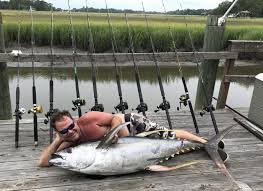
(Marshgrass 1st Mate Derek Eager with the first yellowfin tuna ever caught in North Carolina, June 2018)
The article goes on to say “This wasn’t a run-of-the-mill yellowfin either. The 110-pound weight is after the fish was bled and gutted. When Hass announced the catch over the radio, she said she could almost hear other boats in the area giggling.”
Where “could almost hear other boats in the area giggling”, Tommy is using the false guise of familiarity to obscure the fact that yellowfin tuna did not exist in the Atlantic Ocean off South Carolina prior to 2018.
The listing of the 110 pound gutted weight and the obscuring of the fish’s actual weight by the author are notable.
The Post and Courier’s Tommy Braswell referred to the first, only, and biggest yellowfin tuna ever caught in South Carolina as “not run of the mill”.
That is an example of the rhetorical technique known as “damning with faint praise”.
“While yellowfins are still caught regularly off the North Carolina coast, they’ve all but disappeared in South Carolina waters. The exact reason isn’t known, but Dr. Mitch Roffer, who founded Roffer’s Ocean Fishing Forecasting Service, said it’s likely due to two main reasons.
Overfishing for yellowfin off the coast of West Africa, where many yellowfin historically traveled to South Carolina waters from, is one cause.”
Here in the Punch and Judy tent, you are to imagine that yellowfin tuna regularly travel from West Africa to North Carolina, but those same tuna do not, however, travel regularly from West Africa to South Carolina, which is directly adjacent to North Carolina.
And, while those yellowfin have been “overfished” in West Africa, they are still somehow “caught regularly” in North Carolina.
To make the lie even more spectacular, fisheries.noaa.gov says of the Atlantic yellowfin tuna “The stock is not overfished”, and that “U.S. wild-caught Atlantic yellowfin tuna is a smart seafood choice because it is sustainably managed and responsibly harvested under U.S. regulations”.
Further, a July 2024 article on onthewater.com says “Atlantic yellowfin tuna have four major spawning areas, including the Caribbean, the Gulf of Mexico, and off the coast of Africa.”
If yellowfin tuna are spawning in the Caribbean, right across the Gulf Stream from South Carolina, then why are we even wringing our hands about West Africa?
Dr. Mitch Roffer’s statement that overfishing for yellowfin tuna off the coast of West Africa has caused yellowfin tuna to “all but disappear” in South Carolina is false.
I have exposed his duplicity by using what was known in the old days as “fact checking”.
The plausible-deniability excuses do not have to be logical, or reasonable, or even factual.
The propagandist knows that many or most readers will grasp virtually any straw, no matter how thin, to remain off the hook of personal responsibility.
The article goes on to say “But another major cause, said Roffer, is because of shifts in ocean currents which were once thought to be unchanging. The Antilles Current is one that many fisheries biologists say had once been responsible for bringing yellowfin to South Carolina’s waters, and it has shown lots of changes in the past 10 years, he said.”
Where I must take pains to mention that “has shown lots of changes” is general.
As you may recall, generality is a hallmark of propaganda.
Here in the Punch and Judy tent, you are to imagine that the Antilles current has shifted slightly, so that it is now pointing directly at North Carolina, and, by a whisker, short-changes South Carolina out of all of its yellowfin tuna.
Let’s go to the game films!
Here’s a picture of the Antilles current, which flows northward along Cuba, then into the Gulf Stream, and then right up past South Carolina on its way to North Carolina, and beyond.
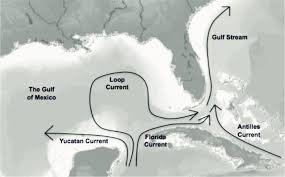
(The Antilles Current)
Here, with a completely straight face, postandcourier.com’s Tommy Braswell is asserting that the yellowfin tuna which are coming from West Africa on the Antilles current are skipping South Carolina, prior to being “caught regularly” in North Carolina.
I have exposed the duplicity of Tommy Braswell and Post and Courier by using what was known in the old days as “fact checking”.
Tommy is desperate to keep you from recognizing that, prior to 2018, damage to the etheric environment had kept the yellowfin tuna from manifesting in the Atlantic Ocean off South Carolina.
Patient readers will recall that the 1979 South Carolina state record yellowfin tuna is fabricated, and that there is no South Carolina state record yellowfin tuna.
In June 2018, the yellowfin tuna winked into existence in the Atlantic Ocean off South Carolina. It weighed approximately 150 pounds.
The Post and Courier’s Tommy Braswell said that it was “the shock of a lifetime”.
I credit him for his sincerity, given that he is is a member and functionary of the Church of Mean-Spirited Western Materialism.
Here’s a picture of Tommy Braswell, in a Satanic purple shirt, and where the image is constructed to focus attention on his left eye.

(The Post and Courier’s Tommy Braswell)
Here’s a picture of Dr. Mitch Roffer, with a Satanic purple screen on the left, and where the image is constructed to focus attention on his left eye.

(Dr. Mitch Roffer)
The images in this article are all focused on the left eye because, to generational Satanist Freemasons, the left eye is the “eye of Will” or the “eye of Horus”.
But don’t take my word for it:
‘The right eye is the Eye of Ra and the left is the Eye of Horus’.”
From “Freemasonry - Religion And Belief - The 3rd Temple”
Facebook: “Welcome to the Left-Hand-Path-Network, where Satanism is not about worship, but it’s study.”
I have included their pictures so that you could get a better idea of what generational Satanist Freemasons of marginal influence look like.
They figured that the rubes would never notice the coded visual imagery.
It’s not like these people aren’t right up front about what they’re doing, and what they’re into. We’ve just been conditioned, over literally Millennia, not to “notice” it.
Generational Satanists are all related to one another through the maternal bloodline. They comprise between twenty and thirty percent of the populace, and are hiding in plain sight in every city, town and village on Earth.
It’s how the few have controlled the many all the way back to Babylon, and before.
But they say that the hardest part of solving a problem is recognizing that you have one.
Don Croft used to say “Parasites fear exposure above all else”.
How long do you think that these people have left in power, now?
Please consider doing what you can to help speed the transition.
In July 2018, (an article) described a “Dramatic fall in North Atlantic heat content”. The article goes on to say “surface and subsurface temperatures of the North Atlantic have fallen to their lowest levels in in more than 30 years.”
On July 26, 2018, orlandoweekly.com said “Look at this massive 826-pound tuna, which is now the new Florida state record”.
Where, under the false guise of familiarity, author Larissa Hamblin redacted “bluefin” from “bluefin tuna”, and walked the largest bluefin tuna in the history of fishing in Florida back to merely “massive”.
And where her statement “new Florida state record” is false, given that there are no Florida state records for the bluefin tuna prior to 2017.
Larissa went on to say “According to the FWC, this catch filled the final vacancy in the conventional tackle category.”
Where, fantastically, the Florida Wildlife Commission is claiming that they coincidentally created a category for the bluefin tuna prior to its appearance within the ecosystem, and then filed it there without comment when it appeared.
The key to any successful Confidence game is misdirection.
In August 2018, an AP News article described “A controversial comeback for a highly prized tuna”.
Shana Miller, The Ocean Foundation’s program manager for global tuna conservation, said a quota increase of hundreds of thousands of pounds was “a bad idea” because of “a possible return to overfishing, and because of concerns that increasingly warming oceans could retard the fish’s reproduction”.
Where Shana’s statement “increasingly warming oceans” is false, given that, in 2016, Robson et al said “since 2005 a large volume of the upper North Atlantic Ocean has cooled significantly by approximately 0.45 °C or 1.5 × 1022 J, reversing the previous warming trend. … The observed upper ocean cooling since 2005 is not consistent with the hypothesis that anthropogenic aerosols directly drive Atlantic temperatures.”
Shana Miller, the Ocean Foundation’s program manager for global tuna conservation, is using conscious deception while retaining the firmness of purpose that goes with complete honesty. She’s lying bald-facedly about the temperature of the Atlantic Ocean in which bluefin tuna are booming and burgeoning to levels never seen previously.
I have exposed her duplicity through what was known in the old days as “fact checking”.
Here’s Shana’s picture, in a Satanic purple and green dress, and where the image is constructed to focus attention on her left eye:

(Shana Miller, the Ocean Foundation’s program manager for global tuna conservation)
The images is focused on her left eye because, to generational Satanist Freemasons like Ocean Foundation Program Manager Shana Miller, the left eye is the “eye of Will” or the “eye of Horus”.
But don’t take my word for it:
‘The right eye is the Eye of Ra and the left is the Eye of Horus’.”
From “Freemasonry - Religion And Belief - The 3rd Temple”
Facebook: “Welcome to the Left-Hand-Path-Network, where Satanism is not about worship, but it’s study.”
I have included her picture so that you could get a better idea of what a generational Satanist Freemason of marginal influence looks like.
She figured that the rubes would never notice the coded visual imagery.
It’s not like these people aren’t right up front about what they’re doing, and what they’re into. We’ve just been conditioned, over literally Millennia, not to “notice” it.
Generational Satanists are all related to one another through the maternal bloodline. They comprise between twenty and thirty percent of the populace, and are hiding in plain sight in every city, town and village on Earth.
It’s how the few have controlled the many all the way back to Babylon, and before.
But they say that the hardest part of solving a problem is recognizing that you have one.
Don Croft used to say “Parasites fear exposure above all else”.
How long do you think that these people have left in power, now?
Please consider doing what you can to help speed the transition.
In August 2018, an article which I cannot at this moment locate said that there were “far more” tuna at fishing tournament in Maine, and that the tournament’s quota increase “reflects a tuna resurgence seen on the water for some time.”
The author bravely averred “seen on the water” to suggest that the tuna had been there all along, only nobody had looked for them with the proper skill or assiduousness, previously.
The said “for some time” to dampen the impact of the fact that the tuna had suddenly winked back into existence in Maine in 2018.
In January 2019, NPR wrung its hands and said “Threatened Bluefin Tuna Sells For $3 Million In Tokyo Market”.
Where NPR’s statement that the bluefin tuna is “threatened” is false, given that Papua New Guinea’s tuna exports more than tripled from 2013 to 2019.
NPR’s use of “threatened bluefin tuna” is an example of the “Big Lie” so favored by Hitler, Goebbels, and small-town Mayors the world over.
In January 2019, Business Insider asked “Why is bluefin tuna so expensive and why is canned tuna so cheap***?***”
With the answer being “a picked generational Satanist shill in Japan stepped up and paid $3M for the tuna (or pretended to), as they were under strict orders to do so, as a ruse, to prop up the failing and wholly-fraudulent “Poor Mother Gaia is Dying” confidence game”.
In August 2019, the Vineyard Gazette widened its eyes to simulate honesty, wrung its hands and said “Once Robust, Bluefin Tuna Fishery Is In Economic Freefall”.
It’s a Black magic spell. It is true that, in 2018, the Atlantic bluefin tuna fishery was in the luridily-but-only-generally described “economic freefall” described by the Vineyard Gazette. However, what they don’t mention is that “once robust” refers to the bottom line of the business operation, when it’s falsely alluded to refer to bluefin tuna numbers in the Atlantic. Which were booming and burgeoning to a point where it collapsed the price of the fish to nothing.
That’s why, just three months later, in January 2020, seafoodsource.com said “Bluefin tuna prices low heading into 2020”. Prices decrease either when supply increases, demand decreases, or both.
Well, if that’s true, why does a Mashed article from February 2020 ask “Why is bluefin tuna so expensive***?***”?
Mashed is using conscious deception while retaining the firmness of purpose that goes with complete honesty. They’re alluding to the new Japanese tradition of the annual ruse-fish.
The month before, in January 2020, bloomberg.com said “Bluefin Tuna Fetches $1.79 Million in Tokyo’s New Year Auction, 2nd Highest Ever”.
The tirelessly-repeated “why is bluefin tuna so expensive” meme is a social engineering tactic that has, to this point, been highly effective. It’s a reference to the annual ruse-fish that a generational Satanist insider in Japan pays way, way way more than they should for. It’s a con, a Confidence game, to prop up the illusion that bluefin tuna are rare, and in dwindling supply.
When the truth is that bluefin tuna are booming and burgeoning to a level never seen previously. Along with all the other tuna. That’s why an Undercurrent News article from January of 2020 is headlined “Tuna sector eyes recovery from record low prices.”
Prices decrease either when supply increases, demand decreases, or both.
“Record” low prices means the lowest tuna prices, ever, in all recorded history.
On August 12, 2019, Adam Speer caught the Washington state record bluefin tuna. It weighed 92.15 pounds.
Theoutdooronline.com’s Mark Yuasa described it as “90-plus pound”.
(Adam Speer with the current Washington state record bluefin tuna, from August 12, 2019. It weighed 92.15 pounds.)
On August 13, 2019, theoutdoorline.com said “Lots of unusual fish being caught in the ocean off Washington including a monster-sized blue fin tuna”.
Where author Mark Yuasa omitted “state record”, and walked the largest bluefin tuna ever caught in Washington back to merely “monster-sized”, where “monster” falsely infers that it was a genetic freak.
Did you notice how Mark deftly separated “blue” and “fin” to avoid plainly stating the more-searchable (and correct) “bluefin tuna”?
That is an example of the propaganda technique known as “compartmentalization”.
As a bonus, Mark used the term “unusual”, which is an example of the propaganda technique known as “stonewalling”.
Mr. Yuasa’s statement that there were “lots of unusual fish” is an example of what is known in the propaganda trade as “chaff”, used to obscure the sudden, exponential increase in size of the bluefin tuna in the Pacific Ocean off Washington.
The people who do this for a living proudly call it “tradecraft”.
The article goes on to say “We’ve seen a bunch of blue fin tuna caught off the coast and I’d say probably 20 or so have been landed by anglers,” said Larry Phillips, the Region 6 Director of the Washington Department of Fish and Wildlife (WDFW) based out of the Montesano office.”
Where “seen”, “landed” and “anglers” all reinforce the false meme that far larger bluefin tuna had been out there in the Pacific Ocean off Washington all along, only nobody had pursued them with the proper skill or assiduousness, previously.
The article goes on to say “Phillips confirmed a 90-plus pound Pacific blue fin tuna was caught Monday (Aug. 12) out of Ilwaco and if verified that would shatter the current state record of 39.20 pounds caught by Sam Ellinger on Sept. 28, 2014. ‘The catches of blue fin have been off the charts compared to what we normally see,’ Phillips said”.
Where “see” reinforces the false meme that bluefin tuna had been out there in the Pacific Ocean off Washington all along, only nobody had looked for them with the proper skill or assiduousness, previously.
Region 6 Director Larry Phillips goes on to say “In most years it’s just a couple fish caught and in some years none. This is a rare one and an adult blue fin is around 130 pounds and in the 7- to 9-year-old class range. Typically, what we encounter are the smaller fish in the teens.”
Here, Larry Phillips, the Region 6 Director of the Washington Department of Fish and Wildlife has lied bald-facedly, given the fact that the bluefin tuna had not been documented in the Pacific Ocean off Washington since 2014, when it had appeared for the first time in history five years earlier at a scrawny 39.2 pounds.
The lies roll forth. Larry’s statement “an adult bluefin is around 130 pounds” is also false, given that the first-ever North Carolina state record bluefin tuna weighed 805 pounds, to name only one of many other examples.
He’s put the randomly-generated 130-pound number forth here to make Adam Speers’ history-making, 92.15-pound Washington state record bluefin tuna seem small. To make a Washington state record bluefin tuna which had suddenly well more than doubled in size seem like it was no big deal.
It’s an example of what is known as Black magic.
I am refuting it here with the White magic of truth.
Larry’s statement “typically, what we encounter are the smaller fish in the teens” is false, given that the only other bluefin tuna on record in Washington, the previous state record from 2014, weighed 39.2 pounds, which is far larger than “smaller fish in the teens”.
Larry says “typically”, which falsely states that the bluefin tuna is common in the Pacific Ocean off Washington. When, in fact, there are just two examples of it on record, one in 2014 and a second in 2019.
Why is Larry Phillips, the Region 6 Director of the Washington Department of Fish and Wildlife getting all his facts wrong?
Why is he saying, with a straight face, that only juvenile bluefin tuna make it to the coast of Washington?
It doesn’t take much to distract the folks in the Punch and Judy tent, I’m sorry to say.
I have exposed the duplicity of Larry Phillips and the Washington Department of Fish and Wildlife by using what was known in the old days as “fact checking”.
In my opinion the street Punch is one of those extravagant reliefs from the realities of life which would lose its hold upon the people if it were made moral and instructive. I regard it as quite harmless in its influence, and as an outrageous joke which no one in existence would think of regarding as an incentive to any kind of action or as a model for any kind of conduct. It is possible, I think, that one secret source of pleasure very generally derived from this performance… is the satisfaction the spectator feels in the circumstance that likenesses of men and women can be so knocked about, without any pain or suffering.
Charles Dickens, letter to Mary Tyler, 6 November 1849

(Illustration proof for the 4th edition of ‘The Tragical Comedy, or Comical Tragedy of Punch & Judy’, by George Cruikshank, about 1859, London.)
In the quote immediately above, Dickens understands that the news is an extravagant relief from the realities of life which would lose its hold upon the people if it were made moral and instructive.
Which is why my mailing list is comprised of 35 individuals.
The article goes on to say “It is highly likely that all these fish commonly found in the southern Pacific Ocean are riding along the warmer big currents that are pushed up into the waters off the Washington and Oregon coast.”
When, in fact, (per Wikipedia) “the California Current (Spanish: Corriente de California) is a cold water Pacific Ocean current that moves southward along the western coast of North America, beginning off southern British Columbia and ending off southern Baja California Sur”.
With a completely straight face, theoutdooronline.com’s Mark Yuasa has called the cold, southward-flowing California Current “the warmer big currents that are pushed up into the waters off the Washington and Oregon coast”.
I have exposed the duplicity of Mark Yuasa and theoutdooronline.com by using what was known in the old days as “fact checking”.
Mark’s hit-piece soldiers on:
“Early last week while fishing in the ocean and at Buoy 10 near the Columbia River mouth water temperatures hovered between 69 and 72 degrees. ’There is definitely a connection between the warmer water temperatures, and these fish commonly found off the central and northern California coast have expanded their range,’ Phillips said. ‘These fish just don’t show up. There must be a pathway with these unusually warm water temperatures and we’ve still got a month of warm water conditions to deal with’.”
Here, with a completely straight face, Larry Phillips, the Region 6 Director of the Washington Department of Fish and Wildlife’s Montesano office said “these fish just don’t show up”, when, in fact, the bluefin tuna had just showed up.
It is an example of the “Big Lie” so favored by Hitler, Goebbels and small town mayors the world over.
Larry stated imperiously that “there must be a pathway with these unusually warm water temperatures”, which falsely implies that the bluefin tuna expanded its range up to Washington because it was riding on a conveyor belt of preferred warm water.
When, in fact, current article on montereybayaquarium.org states “The bluefin tuna is known to dive to chilly depths of 1800 feet (550 meters) and navigate through icy northern waters during their migrations. Unlike most fish, a bluefin tuna’s blood temperature can be warmer than the water around it.”
I’ll add that the largest bluefin tuna in history was caught in the icy waters off Nova Scotia.
I have repeatedly exposed the duplicity of Region 6 Director Larry Phillips and the Washington Department of Fish and Wildlife by using what was known in the old days as “fact checking”.
Did you notice how author theoutdoorline.com’s Mark Yuasa has refused to provide the name of the person who caught the new Washington state record bluefin tuna, and how he also refused to provide a weight for it?
Those are examples of the propaganda technique known as “compartmentalization”.
I have once again exposed the duplicity of Mark Yuasa and theoutdoorline.com by using what was known in the old days as “fact checking”.
Here is a picture of the Washington Department of Fish and Wildlife’s Region 6 Director Larry Phillips, where he’s wearing a Satanic purple and green hat, with a Satanic green “Tree of Life” background, where his left eye is the focal point of the image, and where he’s pointedly holding the fish in his left hand.

(The Washington Department of Fish and Wildlife’s Region 6 Director Larry Phillips)
Now, here is a picture of theoutdoorline.com’s Mark Yuasa, where the image is constructed to focus attention on his left eye, where he has pointedly displayed the fish’s left eye, and where he’s got the thumb on his left hand extended in a purportedly-secret Masonic “gesture of recognition”.
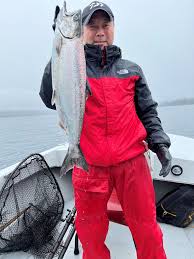
(Theoutdoorlife.com’s Mark Yuasa)
The image is focused on his left eye because, to generational Satanist Freemasons like the New Jersey Monitor’s Nikia Biryukov, the left eye is the “eye of Will” or the “eye of Horus”.
But don’t take my word for it:
‘The right eye is the Eye of Ra and the left is the Eye of Horus’.”
From “Freemasonry - Religion And Belief - The 3rd Temple”
Facebook: “Welcome to the Left-Hand-Path-Network, where Satanism is not about worship, but it’s study.”
I have included their pictures so that you could get a better idea of what generational Satanist Freemasons of marginal influence look like.
They figured that the rubes would never notice the coded visual imagery.
It’s not like these people aren’t right up front about what they’re doing, and what they’re into. We’ve just been conditioned, over literally Millennia, not to “notice” it.
Generational Satanists are all related to one another through the maternal bloodline. They comprise between twenty and thirty percent of the populace, and are hiding in plain sight in every city, town and village on Earth.
It’s how the few have controlled the many all the way back to Babylon, and before.
But they say that the hardest part of solving a problem is recognizing that you have one.
Don Croft used to say “Parasites fear exposure above all else”.
How long do you think that these people have left in power, now?
Please consider doing what you can to help speed the transition.
From 2020 to 2021, the 8.5% average annual increase in size of the California state record bluefin tuna was 150% greater, or well more than twice as great as the 3.4% average annual increase in size of the Virginia state record bluefin tuna from 2015 to 2020.
In 2020, the growth rate of the bluefin tuna began to increase hyper-exponentially, going forward in time.
That’s not scientifically possible, at least not according to the rapidly-collapsing false Orthodoxy which holds that organisms increase in ever-smaller increments to a genetically-programmed maximum size, and that “there is no such thing as the ether.”
The truth is that the health of the ether is inexorably improving, and the size, fertility, longevity and very existence of any organism varies directly with the health of its etheric environment.
In March 2020, the yellowfin tuna winked into existence simultaneously in the Gulf of Mexico off Alabama and Mississippi, and winked back into existence in Virginia for the first time since 2015.
In March 2020, the Mississippi state record yellowfin Tuna weighed 236.6 pounds. It was caught by Mike McElroy III.
Here’s a picture of the 2020 record holder:
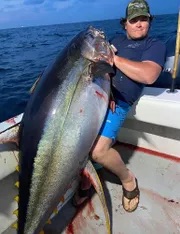
(Mike McElroy III, with his new Mississippi state record yellowfin tuna, from 2020. It weighed 236.6 pounds, and was 15% larger than the previous 205.8 pound record holder from 2001. The record stood for almost twenty years, and then was suddenly broken by an exponential margin.)
The record stood for almost twenty years, and then was suddenly broken by an exponential margin. Such records are usually broken by tiny margins, as the organism will necessarily grow at a slower and slower rate as it approaches its maximum possible size.
In 2020, the Virginia state record bluefin tuna weighed 508 pounds. It was caught by Jake Hiles. Here’s a picture of it:
(Jake Hiles, with his new Virginia state record bluefin tuna, from 2020. It weighed 708-pounds, and was 17% larger than the previous 606 pound record holder from 2015.)
On March 22, 2020, Maurice W. Reddell caught the Alabama state record yellowfin tuna. It weighed 230 lbs. 0 ozs.
Here’s a picture of it.
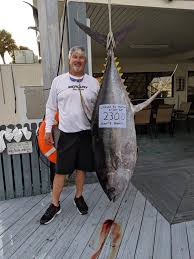
(Maurice W. Reddell with the 230-pound Alabama state record yellowfin tuna, March 2020)
On September 9, 2021, outdooralabama.com said “In March 2020, Maurice Redell boated a 230-pound yellowfin tuna”.
Where the fact that it was an Alabama state record is omitted. That is an example of the propaganda technique known as “compartmentalization”.
There is no mention of a previous Alabama state record yellowfin tuna.
In March 2020, the yellowfin tuna winked into existence simultaneously in the Gulf of Mexico off Alabama and Mississippi.
In March 2020, the yellowfin tuna winked into existence in the Gulf of Mexico off Alabama, at a weight of 230 pounds.
In March 2020, the yellowfin tuna winked into existence in Mississippi at a weight of 236 pounds, 9.6 ounces.
A July 2024 article on onthewater.com says “Atlantic yellowfin tuna have four major spawning areas, including the Caribbean, the Gulf of Mexico, and off the coast of Africa.”
If one of the four major spawning areas of the Atlantic yellowfin tuna is the Gulf of Mexico, as documented by onthewater.com in July 2024, then why was there no Alabama state record yellowfin tuna until 2020?
The truth is that, until 2020, the etheric war had been successful to the point where, while they were hugely plentiful elsewhere, the yellowfin tuna had been unable to manifest in the Gulf of Mexico off Alabama.
On April 23, 2020, wdsu.com said “Massive tuna caught in Mississippi breaks state record”.
Where, under the false guise of familiarity, the uncredited author redacted “yellowfin” from “yellowfin tuna”, and walked the largest yellowfin tuna ever caught in Mississippi back to merely “massive”.
For those unaware, anytime an author is uncredited, it is proof that said author is an Intelligence operative.
The uncredited Intelligence operative from the State propaganda organ known as wdsu.com goes on to say “There’s a new state record in place in Mississippi for Yellowfin Tuna”.
Where “new state record” is a false statement, given that there are no Mississippi state records for the yellowfin tuna prior to 2020.
Did you notice how the uncredited author used the gymnastic “new state record in place in Mississippi” to avoid the plainspoken (and far more searchable ) “Mississippi state record”?
The article goes on to say “Michael McElroy III, of Hattiesburg, landed a fish weighing 236 pounds, 9.6 ounces last month. The previous record, set June 9, 2001, was held by Robert Landingham with a fish weighing 205 pounds, 12.8 ounces.”
To make the grand deception even more spectacular, the Mississippi Gulf Coast Billfish Classic website presents this image to document Robert Landingham’s purported Mississippi state record yellowfin tuna from 2001.
(Photo from an mgcbc.com article which purports to show a yellowfin tuna but in fact shows a swordfish)
The photo immediately above, which purports to show Rob Landingham with his Mississippi state record yellowfin tuna from 2001, in fact shows a swordfish.
It is yet another falsified record, put in place so that, when the yellowfin tuna winked into existence in Mississippi in 2020, there would be a paper trail in place which would allow Coincidence theorists to say “oh, they’ve been there, all along, Rob Landingham caught a big one back in 2001.”
There is no New Jersey state record yellowfin tuna prior to 2022.
In September 2022, the yellowfin tuna winked into existence in the Atlantic Ocean off New Jersey. It weighed 236.5 pounds.
n September 22, 2022, Mark Bennett caught the first-ever Maryland state record yellowfin tuna, in Washington Canyon. It weighed 236.5 pounds.
Here is a picture of Mark and the fish.
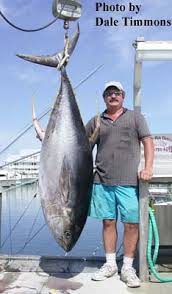
(Mark Bennett with the first-ever Maryland state record yellowfin tuna, September 22, 2022)
On October 9, 2022, bayweekly.com’s C.D. Dollar said “Two weeks ago, the Department of Natural Resources reported that a state record 236.5-pound yellowfin tuna was boated at the Washington Canyon 500 Fathom Tip by Mark Bennett of Salem, New Jersey. According to DNR reports, the big tuna measured 68.75 inches long with a girth of 48.5 inches.”
Where agent Dollar walked the first, only, and biggest yellowfin tuna ever caught in New Jersey back to merely “big”. There is no mention of a previous New Jersey state record.
From May 2023 to May 2024, the bluefin tuna in Alabama increased in size by 38.6%, from 600 pounds to 831 pounds, 6 ounces.
In May 2023, “clients from Georgia” caught a 600-pound bluefin tuna in the Gulf of Mexico off Alabama. It was the first example of the species there in history.
Here’s a picture of it. They’ve got it positioned so that its left eye is accentuated. The one in the middle has their thumb up in a purportedly-secret Masonic “gesture of recognition”.
(The first bluefin tuna ever caught in the Gulf of Mexico off Alabama, 600 pounds, May 2023)
For any Coincidence theorists lingering in the readership, here’s a thumb-up Masonic greeting card.

(Masonic “thumb’s-up” greeting card)
In May 2023, the bluefin tuna winked into existence in the Gulf of Mexico off Alabama, where it had never been documented previously, at a weight of 600 pounds. Then it increased in size by 38.6% over the next twelve months, to 831.6 pounds.
It was not awarded the Louisiana state record thanks to the fraudulent 829-pound 2006 Louisiana state record purported by some to have been caught by some serially-unidentified person at some serially-unidentified location.
On May 5, 2023, al.com said “Orange Beach charter boat reels in 600-pound bluefin tuna: ‘It was a battle’.”
Where, under the false guise of familiarity, author David Rainer omitted the name of the state, to make the subject almost unsearchable. That is an example of the propaganda technique known as “compartmentalization”.
David said “reels in” and “battle” to reinforce the false meme that bluefin tuna had been out there in the Gulf of Mexico off Alabama all along, only nobody had pursued them with the proper skill or assiduousness, previously.
The article goes on to say “Johnny Greene has been a captain on charter boats in the Gulf of Mexico for the past 33 years and has landed his share of the Gulf’s bounty. But recently something happened on his boat, the Intimidator, that had never happened before. Greene and crew unloaded a 600-pound-plus bluefin tuna at the Orange Beach Marina dock.
“At several times in my life, we have been fishing in the April-May time frame and have run across bluefin tuna,” Greene said.”
Where “33 years” is reference to the most important Illuminist number.
The brazenly, blatantly false ruse that it being played here is that bluefin tuna only hit in April and May.
“But we have never been able to even slow one down. I remember on my old boat, I think it was the Memorial Day tournament, we ran through a school of them. We hooked six and they dumped every bit of line we had. It happened so fast, there was nothing we could do. I got my heart broke on that trip. I’ve hooked a couple of others throughout my career. My wife fought one for a while, and the fish ended up pulling the hook.
“Last year we hooked one about noon and fought that fish four or five hours. We had 10 people on that charter, and they ended up changing the rod between anglers probably 20 or 25 times. We ended up breaking a rod after fighting him that long. We were so close, so that one was really a heartbreaker.”
It is a huge, stinking cloud of unsubstantiated bullshit, put forward to create the false picture that the bluefin tuna has been present in the Gulf of Mexico off Alabama. When, in fact, it has not.
In journalistic parlance, this is “buried” seventeen paragraphs below:
“Although it was a giant fish, Greene knew it wasn’t near the state record, an 829-pound fish caught in 2006.”
Where charter captain Johnny Greene walked the first, only and biggest bluefin tuna ever caught in Alabama back to merely “giant”, twice walked “yellowfin tuna” back to “fish”, and then lied bald-fadedly by claiming that there was, in fact, a 2006 Alabama state record bluefin tuna. Which there is not.
For grade school children researching the subject in the future, asking the average American in 2024 to read seventeen paragraphs is asking someone from 1840 to memorize the Declaration of Independence.
Al.com’s David Rainer and captain Johnny Greene both omitted the name of the person who caught the 2006 Alabama state record bluefin tuna, along with the location of that catch.
David omitted them because there is no 2006 Alabama state record bluefin tuna.
There are no independent news articles of the 2006 Alabama state record bluefin tuna, nor are there any photographs of it.
The 2006 Alabama state record bluefin tuna is fabricated; there are no independent news articles verifying this catch, and there are no photographs of this fish.
The bluefin tuna did not appear in the Gulf of Mexico until May 2023; the 2006 Alabama state record bluefin tuna is fabricated, e.g. there are no independent news articles verifying this catch, and there are no photographs of this fish.
Here’s a picture of charter captain Johnny Greene, in a Satanic purple and green shirt, and looking like the sociopath which he is. As a bonus, he’s also making a purportedly-secret Masonic “gesture of recognition”.

(Johnny Greene)
sociopathy - noun - a mental health condition in which a person consistently shows no regard for right and wrong and ignores the rights and feelings of others. Sociopaths tend to purposely make others angry or upset and manipulate or treat others harshly or with cruel indifference. They lack remorse or do not regret their behavior. Sociopaths often violate the law, becoming criminals. They may lie, behave violently or impulsively, and have problems with drug and alcohol use.
Here’s a picture of al.com’s David Rainer, where the image is focused on his left eye, and where he is holding the fish with his left hand.

(David Rainer)
I have included their pictures so that you could get a better idea of what generational Satanist Freemasons of marginal influence look like.
They figured that the rubes would never notice the coded visual imagery.
It’s not like these people aren’t right up front about what they’re doing, and what they’re into. We’ve just been conditioned, over literally Millennia, not to “notice” it.
Generational Satanists are all related to one another through the maternal bloodline. They comprise between twenty and thirty percent of the populace, and are hiding in plain sight in every city, town and village on Earth.
It’s how the few have controlled the many all the way back to Babylon, and before.
But they say that the hardest part of solving a problem is recognizing that you have one.
Don Croft used to say “Parasites fear exposure above all else”.
How long do you think that these people have left in power, now?
Please consider doing what you can to help speed the transition.
In July 2023, the bluefin tuna winked into existence in the Salish Sea, after never having been documented there, previously. It weighed 250 pounds.
Here’s a picture of it.
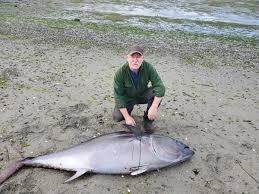
(Gary Lundquist with Bluefin tuna, Salish Sea, June 2023)
In the photo immediately above, take note of Gary’s Satanic green jacket, and how the image is constructed to focus attention on his left eye.
Neither king5.com’s Erica Zucco, SeaDoc Society wildlife veterinarian Joe Gaydos nor Florida University’s Dr. Karly Cohen were able to provided a weight for the only example of the bluefin tuna ever documented in the Salish Sea.
That’s an example of the propaganda technique known as “stonewalling”.
On July 12, 2023, king5.com said “Pacific bluefin tuna found washed up on Orcas Island”.
Where, under the false guise of familiarity, author Erica Zucco omitted “the Salish Sea”, to make the subject almost unsearchable.
That is an example of the propaganda technique known as “compartmentalization”.
The article goes on to say “When SeaDoc Society wildlife veterinarian Joe Gaydos first got a call about a Pacific bluefin tuna spotted at Crescent Beach on Orcas Island, his initial reaction was awe”.
It wasn’t “spotted”, it was found…it was discovered.
Erica used “spotted” to reinforce the false meme that the bluefin tuna had been out there in the Salish Sea all along, only nobody had looked for it with the proper skill or assiduousness, previously.
SeaDoc Society wildlife veterinarian Joe Gaydos use of “awe” is an example of the propaganda technique known as “stonewalling”.
awe - noun - awe dates back to Middle English, and was borrowed from Old Norse, a Scandinavian language. In Middle English the word referred to intense fear.
The article goes on to say:
“Sure enough, this giant tuna was sitting on the beach and it was so beautiful- with the sun coming up and the tuna sitting there, I was like, ‘This is kind of surreal, what’s going on?’" Gaydos said. “Just that morning there was a book being released, ‘Fishes of the Salish Sea,’ all 260 fishes- I thought, I don’t think that fish is even in here.”
Where, magnificently, SeaDoc Society wildlife veterinarian Joe Gados walks “bluefin tuna” back to “giant tuna”, and then walks it back again to “the tuna”, and then walks it back yet again to “that fish”.
Joe’s use of “surreal” and “what’s going on” and “I don’t think” are all examples of the propaganda technique known as “stonewalling”.
It creates the general impression of a weed-smoking wildlife veterinarian, whom the Coincidence theorist reader will reject out-of-hand as a witness.
Is the bluefin tuna listed among the 260 species of fish listed in “Fishes of the Salish Sea”, or is it not?
Well, it is tough to get good marine veterinary help, these days.
For those unaware, anytime someone says “sure enough”, they are lying.
Here, the bald-facedly lying marine veterinarian says, with a straight face, that the 250 pound bluefin tuna was “sitting on the beach”, “sitting there”, without a scratch on it.
Has anyone ever, in history, encountered a beached bluefin tuna? A dead tuna so fresh that it was still warm? Sorry, folks, but generational Satanist Freemason wildlife veterinarian Joe Gados is lying bald-facedly in a mainstream publication.
Here’s Joe Gados’ picture, where he’s got his head pointedly turned to accentuate his left eye, like in a Russian poster of Vladimir Lenin.

(Marine veterinarian Joe Gados, who said that the 250 pound bluefin tuna was “sitting on the beach”, “sitting there”, without a scratch on it, and that it was still warm. Yet Joe also said that he “got a call”, and then headed over to where the tuna was. How long do you think it takes a dead fish that’s just come out of the cold water to get cold in the Pacific Northwest? Joe also said “we determined from particles (that it)…beached itself, basically.”)
Now here’s a Russian poster of Vladimir Lenin, where he’s got his head pointedly turned to accentuate his left eye.

(Vladimir Lenin)
The article goes on to say “He called researchers at the University of Washington’s Friday Harbor Laboratories, who were also surprised to see the species so far north.”
Where “surprised” is an example of the propaganda technique known as “stonewalling”.
The article goes on to say “He sent us a photo of this bluefin and we were all incredibly enthusiastic about it,” Dr. Karly Cohen of the University of Florida said. “I’ve never seen a bluefin tuna up close and personal like that so it was really just a mindblowing experience and it felt unreal even as we were pulling up to the dock to this massive fish that had been placed on a gurney for us to put on a research vessel.”
Where the University of Florida’s Dr. Karly Cohen walked the specific “bluefin tuna” back to the general “massive fish”.
She’s shaking the doll of it being “massive”, and carefully not making mentioning the fact that it is the first example of this species in this ecosystem in history.
As a propagandist, she knows that the key to any successful Confidence game is misdirection.
Karly’s use of the fantastically-unscientific “incredibly enthusiastic”, “mindblowing” and “unreal” are all examples of the propaganda technique known as “stonewalling”.
This strong odor of ignorance will lead the Coincidence theorist reader to reject her out of hand as a witness.
The article goes on to say “NOAA says in the United States, the fish are mostly found within 100 nautical miles of the California coast. Dr. Cohen says while there are some records of bluefin bones washed up in British Columbia, this is an unusual event.”
Where “unusual event” positions it as a one-off, and where “unusual” is an example of the propaganda technique known as “stonewalling”.
Dr. Cohen’s general claim “there are some records of bluefin bones washed up in British Columbia” is brazenly false, given that it is unsubstantiated, hearsay.
The article goes on to say “These are temperate species, they don’t like our cold waters- so it’s quite bizarre and rare that it showed up here," Dr. Cohen said.”
Where the University of Florida’s Dr. Karly Cohen successively walked the specific “bluefin tuna” back to the general “these” and “species” and “they”.
Her statements that bluefin tuna is a “temperate species”, and that “they don’t like cold waters” are both brazenly false.
A current article on montereybayaquarium.org states “The bluefin tuna is known to dive to chilly depths of 1800 feet (550 meters) and navigate through icy northern waters during their migrations. Unlike most fish, a bluefin tuna’s blood temperature can be warmer than the water around it.”
I’ll add that the largest bluefin tuna in history was caught in the icy waters off Nova Scotia.
Dr. Cohen’s statement that the bluefin tuna corpse on the beach in the Salish Sea is “rare” is also false, given that no other example of the species has ever been documented there.
Her once-again fantastically-unscientific use of “bizarre” is an example of the propaganda technique known as “stonewalling”.
It was carefully put there by Dr. Cohen herself to suggest to the Coincidence theorist reader that her own testimony be rejected, as well.
I have exposed the duplicity of Dr. Karly Cohen, marine Veterinarian Joe Gaydos and king5.com’s Erica Zucco by using what was known in the old days as “fact checking”.
Here’s Dr. Karly Cohen’s picture, where she has pointedly turned her head to accentuate her left eye.

(The University of Florida’s Dr. Karly E. Cohen, who studies fish for a living, who said “These are temperate species, they don’t like our cold waters”. When, in fact, tuna are a cold water fish.)
Here’s Erica Zucco’s picture, in a Satanic green dress, and where she has pointedly turned her head to accentuate her left eye.

(King5 News’ Erica Zucco, who was unable to provide a weight for the only example of the bluefin tuna ever documented in the Salish Sea.)
On August 24, 2023, bangordailynews.com’s Susan Young widened her eyes to simulate honesty and said “Although I’ve lived in Maine for nearly 30 years, there’s still a lot I don’t know about this state, especially about the goings-on in the sea waters off Maine’s long coastline.
Like the fact that tuna weighing hundreds of pounds are not that unusual.”
Where “a lot I don’t know” and “are not that unusual” are examples of the propaganda technique known as “stonewalling”.
The truth is that they are, in fact, very unusual, having had just winked back into existence in Maine in 2020 for the first time since the late 1990’s.
On October 5, 2023, nwsportsmanmag.com questioned “Mystery Solved? Podcast Offers More Details About Orcas Island Bluefin Tuna”.
Where “mystery” and the question mark are examples of the propaganda technique known as “stonewalling”.
With this headline, Newport Sportsman Magazine author Andy Walgamott has let us know that he’s going to tell us What To Think.
The article goes on to say “While the Lundquists had a ferry to catch that morning and didn’t bother cutting off any of the meat, another local man did, and it led to social media assumptions about what the impact would be to his digestive system.
Where “another local man” is general. This is a news story. The fact that his name is not used means either that he is being protected by his fellow generational Satanist Freemasons, or he is an invention of the generational Satanist Freemason author.
Here’s Andy Walgamott’s picture, with a Satanic green “Tree of Life” background, where the image is constructed to focus on his left eye, and where he is making a purportedly-secret Masonic “gesture of recognition” .

(Newport Sportsman Magazine’s Andy Walgamott, who said that the “mystery” of the bluefin tuna winking into existence in the Salish Sea was “solved”.)
The article goes on to say “We subsequently learned the guy was just fine, in fact the flesh was just fine,” Adam Summers, a University of Washington professor based at Friday Harbor Labs who dissected the bluefin, told Cox.
Where “the guy” is once again general.
The article goes on to say “Summers also tried some himself after receiving advice from a tuna expert NOT to just discard its flesh. “It was fabulous, fabulous meat. It did not go to waste,” he said.
People like Adam who study fish for a living know what good fish looks and tastes like, and they also know what bad fish looks and tastes like. And people who don’t know anything at all about fish also know those same things. This gymnastic excuse about the unnamed person who also had “some” tuna, and the drama about the fish professor who works at a fish lab who for some insane reason has to check with a specialist to see if he can eat the tuna.
It’s just that they lie so pathologically that it gets bad like this, ofttimes.
“In the podcast, Summers described boating from Orcas back over to San Juan Island with the wrapped-up carcass and realizing just how fresh the fish really was.”
As if the fish professor who works in a fish lab did not know that when he touched the skin of the fish for the first time, and glanced at its clear eyes. This sentence covers up the generational Satanist Freemason fish professor who works at the fish lab who killed the fish and chowed down on it as he drove the boat back to the lab.
The article goes on to say “It started bleeding and it was absolutely fresh arterial-red blood,” Summers said. “It was a typical experience when you just boated a tuna and you see this blood coming out. I knew that we weren’t going to be opening up a four- or five-day-old animal.”
Wait, “it started bleeding”, what? Weren’t “going to be” opening?
Why did it just “start bleeding”? Either from the wounds that unnamed generational Satanist Freemason A inflicted prior to depositing it on the beach, or, obviously, B, the fish professor who works in a fish lab who killed the fish and took it back to the lab, and ate some of it in the boat on the way back to the lab.
Here’s a picture of Marine Biologist Adam Summers, where he has pointedly turned his head to accentuate his left eye.

(Adam Summers, who works at a marine biology lab, who said that he did not think to eat any of the bluefin tuna found in the Salish Sea until “receiving advice from a tuna expert NOT to just discard its flesh.” Did you notice how the “tuna expert” is unnamed? It is a cloud of bullshit, blown to keep you from recognizing that Adam killed the tuna and immediately chowed down on it.)
Here’s another picture of Adam, where the image is constructed to focus attention on his left eye, and where he’s making two different Masonic “gestures of recognition”.

(Adam Summers)
The article goes on to say:
“When I cut into it,” Josh Brown, the man who expertly trimmed off a fillet that July morning on the beach, told Cox over sushi from the fish and beers, “it was still warm. They’re warm-blooded fish.”
Josh Brown, wait, what? Why wasn’t Josh named earlier? And why, and when, was he hanging out with Cox, the generational Satanist Freemason fish professor who works at the fish lab?
Why did King5 News’ Erica Zucco initially not name Josh Brown? And why, when she did eventually mention him, did she simply call him “the man”? The man who, incidentally, “expertly trimmed off a fillet”.
She’s trying to cover up what is obviously an Operation, an Op, comprised of multiple co-conspirators.
Here’s a picture of NOAA Sea Grant’s Joshua Brown, in a Satanic purple shirt, with a Satanic green “Tree of Life” background, and where the image is constructed to focus attention on his left eye.

(NOAA Sea Grant’s Joshua Brown)
How long do you think it takes a fish in the Pacific Northwest’s Salish Sea to get cold, once it’s dead?
Have you ever heard of a tuna beaching itself, ever, in history?
Sorry to be the one to break it to you, but there is foul play involved, here.
The article goes on to say “Summers said that a bluefin expert told him the tuna looked like an “8-year-old fish” that had been on the eastern side of the Pacific for “quite a while” and would have otherwise headed back towards Japan.”
Can you see how “a bluefin expert” is general?
The article goes on to say “As for why it ended up on Orcas, Summers said that bluefin around the world occasionally end up trapped in straits and die there.”
It was happily swimming in the Salish Sea, where it had just winked into existence, when it was hooked by the University of Washington’s Adam Summers, who deposited it “on” Orcas.
Bluefin tuna just dying of starvation or exhaustion, around the world…sorry, that’s just a gigantic, bald-faced lie.
And the lies just keep coming.
“Bluefin are not wired to understand about tides; they’re not really even wired to understand about shoreline,” Summers told Cox. “At this point in their life, they’re traveling in small schools, four to six or eight animals, and the whole school may have ended up in the Salish Sea.”
Fast swimmers, it could have taken a school just a few hours to find themselves deep inside the Strait of Juan de Fuca, where tides, freshwater influences and other factors would have likely further disoriented them, he said.
When the fish was found, a few wags asserted the high-value tuna had been left on the beach as a prank or something, but the podcast suggests otherwise.”
This is a deft technique, if the audience you are preying upon has a grade school education. The general “a few wags” put forward a ridiculous assertion, and then the herd is guided to the wise pronouncements of Joe Gados, who tells them What To Think in his podcast.
The article goes on to say “Eventually, what we determined from particles – gravel and sand in the gills and in the mouth – eventually just making a bad choice about where to be in East Sound as the tide dropped,” Summers told Cox. “And so it beached itself, basically.”
For those unaware, anytime someone says “basically”, they are lying.
Only in America can a marine veterinarian say “we determined from particles” and be believed.
The article goes on to say “The fish was in perfect condition. There were no bruises, there were no issues with the internal organs, but the gills were full of sand and gravel. And the very, very fresh blood convinces us that this animal died just before the tide started dropping.”
That matches the conclusion Washington Coast tuna skipper Mark Coleman reached independently in July. “After a lot of consideration I think it was a lost, cold tuna that died right at the reach of tide,” he told me then.
As I detailed before, there is evidence of bluefin visiting the Pacific Northwest’s outer coast over the millennia in the form of native oral histories and middens, but as Summers pointed out in the podcast, there is none of either for our inside waters.”
Where tuna “skipper” Mark Coleman piled on with “after a lot of consideration”, and then said that the cold-water bluefin tuna was “cold”.
The plausible deniability excuses don’t have to be logical, or reasonable, or even factual.
The propagandist knows that many or most readers will grasp virtually any straw, no matter how thin, to remain off the hook of personal responsibility.
Here’s Mark Coleman’s picture, where the image is constructed to focus attention on his left eye, and where he is pointedly holding the fish in his left hand.
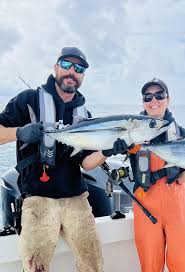
(Mark Coleman, who said “After a lot of consideration I think it was a lost, cold tuna that died right at the reach of tide”. When, in fact, the tuna is a cold water fish, and the tuna was still warm when Josh Brown and Friday Harbor Labs’ Professor Adam Summers started cutting it up.)
On October 16, 2023, komonews published a story on youtube headlined “Mysterious 250 pound tuna found in Salish Sea. No one knew how it got there.”
Where the uncredited author walked the specific bluefin tuna back to the general “tuna”.
That is an example of the the propaganda technique known as “compartmentalization”.
For those unaware, anytime an author is uncredited, it is proof that said author is an Intelligence operative.
The uncredited Intelligence operative from KOMO News used “mysterious” and “no one knew how it got there” in successive examples of the propaganda technique known as “stonewalling”.
Professor Adam Summers and Josh Brown killing the bluefin tuna is part of a modus operandi that is on display numerous times in my article on the etheric origin of species.
A good example is found in a gizmodo.com article by Tom McKay from September 20, 2017, headlined “Jerk Humans Immediately Shoot First Wild Bison Seen in Germany for Over 250 Years”.
Where “jerk humans” is a general meme used to cover the specific “generational Satanist Freemasons”.
To get out of this situation we’re obviously going to need to make some changes.
But they say that the hardest part of solving a problem is recognizing that you have one.
In 2024, the 831-pound, 6-ounce verified Alabama state record bluefin tuna was 1.5% larger than the 819-pound verified Maine state record bluefin tuna from 1977.
In April 2024, Captain George Gill, boat owner Warren Williams, Eddy Griffith, Dennis Bennet, John Balters, and Kole Melancon caught the largest bluefin tuna in the history of fishing in Florida. It was ineligible for the Florida state record because more than one person landed it. It weighed 888 pounds.
On April 26, 2024, sports.yahoo.com said “Giant, 888-Pound Tuna Is the Largest Ever Caught off Florida Coast”.
Where, under the false guise of familiarity, author Bob McNally redacted “bluefin” from “bluefin tuna”, to make the subject less searchable.
That is an example of the propaganda technique known as “compartmentalization”.
Bob walked the biggest tuna ever caught in the history of fishing in Florida back to merely “giant”, and said it was “the largest ever caught off Florida Coast”, where “coast” hold out false hope to the Coincidence theorist reader that larger tuna had been caught farther out at sea.
What makes the misleading statement “off Florida coast” all the more spectacular is that they were 68 miles out when they caught it.
The article goes on to say “The tuna was so massive that the anglers had a hard time getting it through the open stern door and up to the scales on the dock. An onlooker posted videos of their struggle on Facebook, along with several photos showing how giant the tuna was. The bluefin measured 110 inches, or more than 9 feet, long and weighed 888 pounds on the scale. Had only one angler reeled it in, the fish would have easily broken the standing state record for bluefin tuna, an 826.5-pounder caught in 2017.”
Where sports.yahoo.com’s Bob McNally walked the biggest bluefin tuna ever caught in Florida back to merely “massive”. As a bonus, he included “so massive” to distract from the sleight-of-hand.
Then, under the false guise of familiarity, he called it a “tuna”, and then he called it a “bluefin”, in both cases to avoid writing the more-searchable “bluefin tuna”.
Those are examples of the propaganda technique known as “compartmentalization”.
This was the first time the crew had taken the new Viking out, Captain George Gill told the Destin Log. Joining Gill onboard were the boat’s owner Warren Williams, along with Eddy Griffith, Dennis Bennet, John Balters, and Kole Melancon. The anglers ran 68 miles offshore to work around some floating “fish aggregating devices” — which are large, man-made floating objects designed to attract tuna, dolphin, and other fish.
On May 29, 2024, David Gaston caught the first-ever Alabama state record bluefin tuna. It weighed 831 pounds, 6 ounces.
On June 5, 2024, bassmaster.com said “Daily Limit: Gaston lands pending Alabama record bluefin”.
Where, under the false guise of familiarity, author Mike Suchan redacted “state” from “state record”, and redacted “tuna” from “bluefin tuna”, in both cases to make the subject far less searchable.
Those are examples of the propaganda technique known as “compartmentalization”.
Mike said “lands” to reinforce the false meme that far-larger bluefin tuna had been out there in the Gulf of Mexico off Alabama all along, only nobody had pursued them with the proper skill or assiduousness, previously.
The article goes on to say “After almost a half-day battle, second-year Elite pro David Gaston brought in the pending Alabama state record bluefin tuna on May 30. ‘That was a big ’un. A real big ’un,” said the 27-year-old from Sylacauga, Ala. “It was a pretty big deal catching it. It weighed 831.6 pounds. The original record was 829. I’m supposed to get a call back, but right now it’s the pending state record.”
Where bassmaster.com’s Mike Suchan used “battle” and “brought in” and “catching” to hammer the false meme that far-larger bluefin tuna had been out there in the Gulf of Mexico off Alabama all along, only nobody had pursued them with the proper skill or assiduousness, previously.
Angler David Gaston walked the biggest bluefin tuna ever caught in the Gulf of Mexico off Alabama back to merely “big”, and then allowed that it was “real big” to distract from the sleight-of-hand. Then he brazenly hedged again and said that it was only a “pretty big deal”.
Neither bassmaster.com’s Mike Suchan nor angler David Gaston mentioned when the previous record was set, or who set it.
Those are examples of the propaganda technique known as “compartmentalization”.
An instagram post showing Gaston’s catch does not mention anything about a previous Alabama state record bluefin tuna. That’s because they know that, if they mention it, someone will look it up and find that it is not substantiated by any independent news articles, and they’ll also find there there are no photographs of it.
Here’s a picture of angler David Gaston, where the image is contructed to focus attention on his left eye, and where he’s holding the lure in his left hand.

(Angler David Gaston)
Here’s a picture of bassmaster.com’s Mike Suchan, where the image is blatantly off-center to highlight his left eye.

(Bassmaster.com’s Mike Suchan)
Mike and David’s pictures both focus on the left eye because, to generational Satanist Freemasons, the left eye is the “eye of Will” or the “eye of Horus”.
But don’t take my word for it:
‘The right eye is the Eye of Ra and the left is the Eye of Horus’.”
From “Freemasonry - Religion And Belief - The 3rd Temple”
Facebook: “Welcome to the Left-Hand-Path-Network, where Satanism is not about worship, but it’s study.”
I have included their pictures so that you could get a better idea of what generational Satanist Freemasons of marginal influence look like.
They figured that the rubes would never notice the coded visual imagery.
It’s not like these people aren’t right up front about what they’re doing, and what they’re into. We’ve just been conditioned, over literally Millennia, not to “notice” it.
Generational Satanists are all related to one another through the maternal bloodline. They comprise between twenty and thirty percent of the populace, and are hiding in plain sight in every city, town and village on Earth.
It’s how the few have controlled the many all the way back to Babylon, and before.
But they say that the hardest part of solving a problem is recognizing that you have one.
Don Croft used to say “Parasites fear exposure above all else”.
How long do you think that these people have left in power, now?
Please consider doing what you can to help speed the transition.
